В.Кондратьев Самолеты первой мировой войны
Сопвич "Кэмел" / Sopwith Camel
Цельнодеревянный одностоечный биплан со смешанной обшивкой фюзеляжа (передняя часть - дюралевые листы, борта кабины и закабинный гаргрот - фанера, остальное - полотно). Крылья и оперение обшиты полотном. Как и предыдущие истребители фирмы "Сопвич", самолет разработан инженером Гербертом Смитом.
Первый прототип, оснащенный 110-сильным ротативным мотором "Клерже" 9Z и вооруженный двумя синхронными пулеметами "Виккерс", вышел налетные испытания в декабре 1916 г. Для улучшения аэродинамики казенные части пулеметов были прикрыты дюралевым обтекателем, придававшим машине характерный, слегка "горбатый" профиль, за который она и получила свое название (по-английски camel - верблюд).
После успешного завершения испытаний в мае 1917-го "Кэмел" запустили в крупносерийной производство. Первые авиачасти - 4-й дивизион RNAS и 70-й дивизион RFC - получили новые истребители в июле того же года.
На большинстве серийных экземпляров стояли 130-сильные двигатели "Клерже" 9B или еще более мощные 150-сильные "Бентли" BR.1. Некоторые оснащались 110-сильными "ронами", такие машины, преимущественно, служили в ПВО.
Благодаря малой нагрузке на крыло в сочетании с довольно высокой энерговооруженностью и плотной компоновкой машины вокруг центра масс, "Кэмел" обладал исключительной горизонтальной маневренностью. Радиус левого виража составлял всего 15 м! (правый из-за гироскопического момента ротативного мотора был немного шире). Английские летчики шутили, что "Кэмел" способен "вертеться на месте вокруг своего хвоста". Максимальная скорость и скороподъемность, особенно - с двигателем "Бентли", также не вызывали претензий.
На основании высоких оценок пилотов и командиров строевых частей руководство RFC и RNAS уже в 1917 году заказало 3450 экземпляров истребителя (до конца года построено 1325), а в дальнейшем последовали дополнительные заказы. Общий итог серийного выпуска "Кэмела" составил 5695 штук, что делает его самым массовым английским истребителем Первой мировой войны. Но он был не только наиболее многочисленным, но и самым результативным. Согласно официальным английским данным, "Кэмелы" одержали в общем счете 2790 воздушных побед, то есть больше, чем любой другой тип истребителя из стран Антанты.
"Кэмелы" выпускались и активно применялись до конца войны. К моменту заключения перемирия на вооружении RAF числилось 2549 самолетов этого типа в составе более чем 30 истребительных авиадивизионов. Кроме того, на "Кэмелах" в 1918 году воевали четыре американских дивизиона и две бельгийских эскадрильи, а после войны эти самолеты состояли на вооружении в Канаде, Греции и Польше. Они применялись в советско-польской и греко-турецкой войнах.
По нескольку экземпляров машины входило в 47-й английский дивизион и так называемый "Славяно-британский авиакорпус", воевавшие в 1918-19 годах на стороне белогвардейцев в России. 47-й дивизион действовал в Поволжье, а "Славяно-британский авиакорпус" - на севере, в районе Архангельска. По крайней мере, два "Кэмела" из их состава в ходе боев были захвачены Красной армией.
Модификации
"Кэмл" F.1 - с двигателем "Клерже-9b", с двумя 7,69-мм пулеметами "Виккерс", мог нести две 9-кг бомбы;
"Кэмл" Е.1 - кроме двух синхронных, установлен надкрыльевый пулемет, стреляющий вне диска вращения винта. Усилено бомбовое вооружение (четыре 9-кг бомбы). Отличался увеличенным на 0,22 м размахом крыльев и удлиненным на 0,2 м фюзеляжем. Кабина смещена назад для удобства стрельбы из надкрыльевого пулемета.
Проектировался двухместный вариант учебно-тренировочного истребителя. Построен единственный экземпляр, испытывался, но серийно не строился.
43 машины дооборудовались и использовались как палубный истребитель для авианосцев типа "Фьюриес" до середины 1920-х годов.
ЛЕТНО-ТЕХНИЧЕСКИЕ ХАРАКТЕРИСТИКИ
с моторами"Клерже" "Бентли"
Размах, м 8,50 8,50
Длина, м 5,72 5,60
Высота, м 2,72 2,72
Площадь крыла, кв.м 21,50 21,50
Сухой вес, кг 422 470
Взлетный вес, кг 660 695
Двигатель Клерже-9b Бентли BR.1
мощность, л. с. 130 150
Скорость максимальная, км/ч 183 199
Скорость подъема на высоту
2000м, мин.сек 6,00 5,00
Дальность полета, км 350
Потолок, м 5790 5650
Экипаж, чел. 1 1
Вооружение 2 пулемета
18 кг бомб
А.Шепс Самолеты Первой мировой войны. Страны Антанты
Сопвич "Кэмл" (Camel) 1917 г.
Развитием самолета Сопвич "Пап" стал истребитель "Кэмл" - одностоечный биплан цельнодеревянной конструкции. Отличался в основном конструкцией крыльев, которые имели больший на 0,4 м размах и меньшую хорду. Верхнее крыло без поперечного V, нижнее крыло имело поперечное V большее, чем у "Сопвич-Пап". Фюзеляж и оперение имели незначительные отличия. Хвостовая часть фюзеляжа несколько опущена по сравнению с самолетом "Пап". Вооружение более мощное, чем у истребителей "Пап". Для лучшего обзора в центроплане делалось два проема, закрытых целлулоидом. Двигатель 9-цилиндровый, воздушного охлаждения, звездообразный "Клерже-9b" мощностью 130 л. с. (на "Кэмл" F.1) или 180 л. с. (на "Кэмл" E.1). Летные данные значительно возросли и находились на уровне аналогичных машин германских ВВС, хотя несколько уступали "Ньюпор-27c1" и SPAD S. Машина выпускалась массовой серией. Всего построено 5490 самолетов этого типа.
Модификации
"Кэмл" F.1 - с двигателем "Клерже-9b", с двумя 7,69-мм пулеметами "Виккерс", мог нести две 9-кг бомбы;
"Кэмл" Е.1 - кроме двух синхронных, установлен надкрыльевый пулемет, стреляющий вне диска вращения винта. Усилено бомбовое вооружение (четыре 9-кг бомбы). Отличался увеличенным на 0,22 м размахом крыльев и удлиненным на 0,2 м фюзеляжем. Кабина смещена назад для удобства стрельбы из надкрыльевого пулемета.
Проектировался двухместный вариант учебно-тренировочного истребителя. Построен единственный экземпляр, испытывался, но серийно не строился.
43 машины дооборудовались и использовались как палубный истребитель для авианосцев типа "Фьюриес" до середины 1920-х годов.
ЛЕТНО-ТЕХНИЧЕСКИЕ ХАРАКТЕРИСТИКИ
"Кэмл" F.1 1917 г. "Кэмл" Е.1 1917г
Размах, м 8,50 8,67
Длина, м 5,72 5,93
Высота, м 2,72 2,72
Площадь крыла, кв.м 21,50 21,50
Сухой вес, кг 422 430
Взлетный вес, кг 660 660
Двигатель Клерже-9b Клерже-9b
мощность, л. с. 130 180
Скорость максимальная, км/ч 183 183
Скорость подъема на высоту
2000м, мин.сек 6,00
Дальность полета, км 350 430
Потолок, м 5790 5780
Экипаж, чел. 1 1
Вооружение 2 пулемета 3 пулемета
18 кг бомб 36 кг бомб
H.King Sopwith Aircraft 1912-1920 (Putnam)
F.1 Camel
To begin what will rightly be expected to comprise one of the most important chapters of this book with what may seem to be a blatant heresy will at least have the merit of originality; and anything original concerning the most famous and successful British fighter of the First World War must inevitably verge on the heretical, for so many facts have been enunciated relative to the Camel by so many authors, and even by authorities. The heresy referred to is one that Rudyard Kipling (who really gave the Sopwith Bat Boat its name) might well have supported, if one gives any credence to the second of his Just So Stories (1902). This story Kipling called 'How the Camel got his Hump' and he himself supplied illustrations in a style which might have got him a job as a Sopwith draughtsman had he failed with his text.
To keep our present tale on strictly Sopwith lines we may restate in typical terms an accepted belief: that the Sopwith Camel - a two-gun development of the Pup - was so named because 'the breeches of the guns were enclosed in a prominent humplike fairing'.
The heresy now uttered against such statements is in part demonstrable and in part suggested. Demonstrable first is that the 'breeches' (allowing a 0.303 in Vickers gun to have a breech at all, and not a chamber) were in any case invisible, being buried quite deeply among the 'action' contained in the 'action body', 'breech casing' or 'receiver'. So the 'breeches' of the two Vickers guns (which guns were so characteristic of the Camel, for it was the first British machine of its class to have them as standard equipment) were enclosed not by the equally characteristic hump-like fairing or scuttle but by the casings lying under that protuberance. What the 'hump' did in fact cover was not only the rear parts of the guns themselves, but often some quite complicated external fittings associated with firing and loading. Furthermore, the hump functioned partly as a windscreen for the pilot and contributed directly to the uncommonly poor field of view available to him.
Thus it is plainly suggested that the famous hump on the Camel's fuselage afforded a contributory - and not an absolute - explanation of the aeroplane's name; for in the 1920s, and on into the 1930s, the present writer was repeatedly assured sometimes by demonstration and usually by men who knew the Camel and its antecedents well - that equally, if not primarily, responsible, was the absence of dihedral on the upper wings and the sharpness of that angle on the lower ones. These features, quite obviously, combined to give a 'round-shouldered' or 'hump-backed' appearance which was (equally obviously) accentuated by the fairing ahead of the cockpit. In some degree this is borne out by an account by Oliver Stewart who, having mentioned the 'hunched shoulders just below the centre section' goes on to refer in the same sentence to 'the arrangement of the planes with the marked dihedral angle on the bottom plane and the straight top plane.' Less known perhaps, but hardly less compelling, is this following - by another Camel pilot of the RFC:
'Those at the C.F.S. in the early months of 1917 will recall when the first rumours of the Camel floated round the mess ... Someone brought the news "Sopwith has produced a machine with a 130 hp engine. It'll do 130 level and climb 10.000 feet in six minutes. It has two guns through the prop." ' And later: 'There, in amongst the graceful two-seaters, sat a squat contrivance looking much more like a frog than a camel. I gazed with awe into the cockpit, felt the tail for improvement on that of the 1 1/2 Strutter, and tried to fathom the Kauper gear. In no time I had Mr. Hun well in hand, and if I didn't hit him it was not the fault of the Camel, or the Vickers, or ought else.'
And so we have 'this squat contrivance' presented, as it were, first-hand - with only the performance figures discredited!
Equally, now, we may discredit the 'What's in a name?' viewpoint: for the two synchronised Vickers guns that lay partly beneath its hump constituted, in effect, the Camel's very heart, forming, as they did with the ammunition and the engine beneath them, and with the pilot and petrol close behind them, a concentration of masses that was a primary factor in the Camel's astonishing powers of manoeuvre. 'Mr. Hun', as the quoted pilot called him, was certainly 'well in hand'; and the gentleman thus specifically addressed was generally the pilot of any of Germany's new Albatros single-seaters - armed though these were (like the Camel) with twin fixed guns. Thus, having noted that the Camel's guns constituted, in effect, its very heart, (and were not merely appendages that caused a growth on the top decking) we may consider armament before 'ought else'.
By reason of the small dimensions that were allied with the concentration of masses, the Camel's two Vickers guns were set only a few inches apart. Thus this fighter presented quite acute problems in ammunition-feeding and ejection, though towards the end of 1917 - less than a year from the type's first appearance - these problems were mitigated by a significant development. This development was the introduction of a 'left-hand feed block' (the standard Vickers gun was fed from the right-hand side) so that ‘handed' guns were now generally adopted - on the Camel first of all. It must be emphasised however that the earliest Camels - both experimental and production had "R.H. feed blocks" (right-hand) for both guns.
Here one would stress effectiveness of armament as distinct from sheer weight of armament (as commonly expressed by the number of guns installed), having now especially in mind the 'Hazelton attachment' or 'speeding-up set' that was first introduced as standard equipment on the Camel as the war neared its end, and the significance of which has never been generally acknowledged. Lord Balfour of Inchrye (or Major Harold Balfour as he was at the time) once declared that this fitment increased the chances of a fighter pilot by 100 percent (that is, the rate of fire of the Vickers gun was increased - very roughly from 500 rounds per minute to 1.000). Disadvantageous though this development was to the enemy, it came as no unmixed blessing, for wear and tear on the guns themselves could prove quite distressing to an armament officer. Nevertheless, one appends this testimonial from an RFC fighter pilot:
'With two guns firing at the rate of from 400 to 600 rounds a minute it was astonishing what pilots missed. They often got right on the tail of their objective and went on firing, and simply nothing happened at all, and one did not know where the shots were going. Towards the end of the war, when destruction of the enemy increased a great deal, I understood it was due entirely to the speeding up of the firing to 2,000 rounds a minute, and I believe that was the sole cause of pilots coming into the killing class where previously they had been in the missing class.'
What a testimonial indeed, from and for a fighting man - 'into the killing class ...' Yet what of the exceptional powers of manoeuvre that enabled the Camel's guns to be brought so effectively to bear, and which were attributed (in brief) to the super-sensitive ailerons and elevator - the latter in particular; to the concentrated masses already mentioned; and the gyroscopic, or torque, effect of the relatively powerful rotary engine, which enabled this fighter to turn unusually smartly to the right? 'Take the Sopwith Camel and the S.E.5', invited that master-pilot Sqn Ldr R. M. Hill, 'two conceptions diametrically opposed.' Pronouncing:
'The S.E.5a is stable with elevators free, the Camel unstable with them fixed. The Camel is more lightly loaded and has, with the exception of the rudder, more powerful controls. In a dive the Camel is flicky, due to lighter loading and excessive longitudinal instability; the S.E.5a is very steady, but dull to small intentional movements. In a zoom the Camel improves greatly owing to its lighter loading and instability; the S.E.5a is inclined to become languid, and its stability near stalling draws down the nose so that a large backward stick movement has to be made. In a Camel the pilot has always to make small movements of controls to pick up steady speed which is difficult to maintain. Going into a dive, compared with the S.E.5a, the elevators of the Camel work the reverse way: the stick, though initially pushed forward, has to be pulled right in again, but the S.E.5a, if the stick is pushed forward, would drop its nose, creep up to trimming speed, and stay there. The S.E.5a is impossible to fly inverted: the Camel may remain so unintentionally. Nevertheless there is no doubt that the conception of the Camel as a fighting aeroplane made an irresistible appeal to a certain class of pilot, but it never could be comparable with the S.E.5a because, even assuming that it possessed certain qualities equal or even superior, the difference in performance from 7 to 10 mph at 15.000 ft - and the view, gave the S.E.5a a superiority that only fighting pilots really understand.'
'Irresistible to a certain class of pilot' - evidently the 'killing class' ... Even so, the Camel was not everybody's meat - least of all the enemy's, as witness the 1,200-odd victories that have been credited to it. Which may be reckoned a fair return for just under 5,500 F.1 Camels built.
The F.1 Camel, which owed something to the Baby as well as to the Pup, was designed for land operation, though it was used by shore-based squadrons of the RNAS as well as by the RFC; and that very early (and specialised) Naval interest was manifest in the design is clear from the succeeding chapter on the 2F.1. Unnumbered, though having a sizable blank panel on the fuselage apparently for some identification marking, the first Camel was cleared by the Sopwith Experimental Department on 22 December, 1916. Back at the drawing-board stage, some slight or moderate dihedral had been envisaged for the top wings as well as the bottom ones, the deciding factor in the straight-top-wing decision, it seems, being the possibility of one-piece construction (this demanding coarser dihedral on the lower panels).
On the first Camel, the top line of the 'hump' sloped upwards to the front rim of the cockpit, so that the cockpit looked unusually deep and obstructive to view - the more so as it was flanked by the rear 'centre-section' struts and because there was no cut-out in the top wing other than the little 'bite' out of the trailing edge. The marked trimness of appearance was accentuated by the absence of a windscreen of familiar type; by the cup-shaped fairings over the muzzle attachments and the front ends of the barrel casings of the guns (as on some later Camels); and by the pristine 'engine-turned' and burnished aluminium cowling over and behind the 110 hp Clerget 9Z rotary engine. Beside this aeroplane even a Pup would have looked 'bitty' (though never clumsy), while the snubness of the Camel's nose, with the guns ending in line with it so short was the fuselage-contributed further to the 'stumpy-humpy' aspect of Sopwith's new creation.
Apart from the one-piece top wing there was little that was startling in the wire-braced wooden structure, with its plywood cockpit-sides. Even so, the whole machine suggested a triumphant conspiracy between an armourer, an aero-dynamicist and a demanding fighter pilot - the last of these being rightly named, even though the four ailerons (later lengthened) finished in line with the interplane struts.
The Camel that was clearly regarded as the first major experimental variant was a very different aeroplane indeed - so much so in fact that the designation conferred was apparently F.1/1, though for reasons clearly obvious it was otherwise called the Taper(ed) Wing Camel. With its single deep-chord interplane struts (recalling those of the Triplane), its blunt-tipped wings sharply tapered both in plan-form and thickness, and its 110 hp or 130 hp Clerget engine, this version was otherwise distinguished by a central rectangular cut-out in the top wing, additional to a specially shaped cut-out in the trailing edge, which appreciably reduced the 5-ft (1.52 m) chord above the fuselage. Disappointingly, this 'super-Camel' gave poor results when officially tested in May 1917, landing-speed, for instance, being higher and manoeuvrability inferior, and development was not apparently pursued, though a '4F.1 Taper Wing Camel' was under discussion in December 1917. It is worth remarking, nevertheless, that although a one-piece top wing is generally (and respecting one form at least, correctly) attributed to the Taper Wing Camel, the head-on photograph now reproduced (seemingly taken by a Weybridge photographer, and having no lettered-on Sopwith caption) appears to show a top wing in three sections. Also in the context of the Camel variant now discussed, it may be noted that whatever designation may have been formally applied, a side view that has now become familiar, and a detail of which was shown in Armament of British Aircraft 1909-1939 (page 332), bears the following Sopwith caption: "S. 127 - Sopwith 'Camel' - 110 hp Clerget - Type F.1 Tapered Wings 1917 - 3rd. Machine".
Suggestive that the description 'super-Camel' earlier applied to the taper-winged form was not over-sensational, and that this development constituted an exercise in aerodynamic cleanness as well as structural refinement, was the fitting of deep-chord fairings on the V-struts of the landing gear (thus more or less matching with the interplane struts). A further point of interest in this regard is that the landing gear fairings may not be present on the aircraft as seen in the head-on view now reproduced - the steel-tube members being wholly exposed.
That there were several experimental Camels is certain, and that some of these were Sopwith private-ventures equally so, though obscurities remain. Nevertheless, it seems definite that the Camel F.1 to which the Admiralty number N517 was allocated was at Brooklands for test as early as 26 February, 1917, and that by the following May N518 - with the new Admiralty Rotary A.R.I engine (first flown in a Camel in April) - was at Martlesham Heath. Not until July was this new British engine redesignated B.R.I in deference to its designer, W. O. Bentley, who had served at Gwynnes Ltd to keep a Naval eye on Clerget developments.
The significance of the presumably-existing designation F.1 /2 is unsure, though it may conceivably have been deliberately 'missed out' (for the practice has not been unknown in the past) to avoid confusion with 2F.1, later defined, or equally conceivably, have connoted the version which retained the one-piece, constant-chord top wing and short ailerons but had a rectangular cut-out at the top-wing centre. Certainly a variant so distinguished existed at a relatively advanced stage of Camel development, as witness the flattened 'hump' ahead of the cockpit (the general form that was standardised, and that may also have been used on the two-gun Sopwith-built Triplane N5445) - with the addition of a transparent windscreen. Even so, Sopwith photograph S.122 shows a form which is declared as '2nd. Machine' and which is characterised by lengthened ailerons, a three-piece top wing, no transparent windscreen and differences of detail (e.g. cowling). A four-figure number prefixed by 'N' almost certainly proclaims the subject-aircraft as N6332, thus making this particular '2nd Machine' the second, perhaps, to be completed of the first Sopwith production batch (N6330-N6379). A dead-rear view evidently taken on the same occasion was similarly described, the print being numbered S.121.
The F. 1/3 is defined in an official document giving airframe, engine and loading details, and especially a detailed weight breakdown and affording confirmation that the aircraft thus defined would correspond in all essentials with the first production form of the F.1.
Although the tabulation just mentioned gives the engine as a '130 Clerget (delivering 127.75 'nominal bhp' at 1,250 rpm) official documentation on the early F.1, in the form wherein the type first entered service, affirms that the '150 h.p. A. R.1' was 'in some cases' fitted. Other engines than the 130 hp Clerget 9B that were installed in the form of the aircraft that was called F.1/3 were the 110 hp Le Rhone 9J (tested in May 1917 the Clerget 9B having been tested in March) and the 140 hp Clerget 9Bf (tested July). As already mentioned, an Admiralty Rotary A.R.I (Bentley B.R.I) had been flown in April, and RNAS Camels, deliveries of which began on 7 May, 1917, were, as also intimated, fitted with this engine as an alternative to the 130 hp Clerget - and soon giving rise to the term 'Bentley-Camel'. Not until August 1917 were tests made at Martlesham Heath with a 100 hp Gnome Monosoupape (sometimes fitted in Service Camels), this installation being followed in December 1917 by trials with a new type of Gnome Monosoupape, nominally of 150 hp, though never standardised for British Camels. Late in 1918 the 150 hp Gnome Monosoupape installation was revived by the US Air Service, the Americans having been impelled towards the Gnome after dissatisfaction with plans for Clerget manufacture. The most powerful nine-cylinder rotary engine fitted to a Camel however (and all wartime Camel engines were of this general form) was the 170 hp Le Rhone 9R, the first experimental installation of which was made in France in the Sopwith-built F.1 numbered B3891 and which the French Government had acquired.
For the RFC, Camel contracts were placed by the War Office in May 1917 (the month in which Naval deliveries began), the first contract recipients being Ruston Proctor & Co who had formerly made 1 1/2 Strutters. 'Rustons' were, in fact, to make a total of over 1,500 Camels, the first of which was finished in June 1917, and peak production by this company was 128 in a month May 1918, just before phasing-out in favour of the Snipe. Sopwith's own output of F.1 Camels was only about a third of Ruston Proctor's - roughly equalling Clayton & Shuttleworth's though representing only about a tenth of the total of nearly 5,500. Boulton & Paul rivalled even Ruston Proctor, and far surpassed British Caudron, Hooper, and other constructors whose orders are set out at the end of this chapter.
Production F.1 Camels had a three-piece top wing and lengthened ailerons; but a feature that seems to have caused special comment in Germany was the fixed tailplane, as witness this 1918 report 'from an enemy source': 'The wing spars, which are made of spruce, are spindled out to an I section, with the exception of the bottom rear spar, which is left solid ... The tail plane, which is deeply cambered on both sides, is rigidly attached to the upper body longerons, with an angle of incidence of 1.5 deg. The tail plane trimming gear hitherto fitted to all Sopwith machines has been abandoned, in spite of the fact that the petrol tanks are placed behind the pilot's seat.’
Engine cowlings varied less than might be supposed, the frontal lip being an unbroken circle, accentuating the snub nose, though sometimes quite extensively slotted round parts of the perimeter for additional cooling in high temperatures or at low altitudes – or, perhaps, in association with a special engine (e.g. Le Rhone 9R). Propellers of many patterns were tried, especially as the Camel was noted for climb rather than level speed, though many factors - including engine type, make and state, and sometimes involving such fundamentals as compression ratio and carburetion - could easily invalidate investigations. Time to 10.000 ft, for instance, could vary from around a mere 8 minutes to something of the order of 16. ‘Rationalised’ data are therefore quoted at the end of this chapter for the F.1 Camel in seemingly representative states and with each of the three commonly fitted engines (110 hp Le Rhone, 130 hp Clerget, and 150 hp B.R.I). The prices of these engines were respectively ?771 10s, ?907 10s and ?643 10s, whereas the F.1 airframe without engine, guns or instruments was ?874 10s.
Respecting mechanical 'extras' and prices, the item which an earlier-quoted pilot described as the 'Kauper gear' (and which he tried to 'fathom') now commands attention; for, although mention has already been made, in connection with the 1 1/2 Strutter, that 3,950 sets of the Sopwith-Kauper synchronising gear for the Vickers gun were supplied to the flying services, and 2,750 installed, it must now be noted that a good proportion of these sets must have been used on early twin-gun Camels. In any case, the royalty on each is said to have been ?1. The nature and recipient of this sum is not known, but the gear was certainly fitted to aircraft other than Sopwiths - the Bristol M.1C Monoplane for instance. Curiously enough, an example of this aeroplane (though without armament) was being operated after the war in Australia by Harry Kauper himself jointly with Capt Harry Butler.
Though first made in 1916, the Sopwith-Kauper gun-gear was developed in several patterns, but in essence was of 'rod-and-spring’ type, the spring actuating the gun's firing mechanism when permitted to do so by a controlling cam rotated by the engine. As for the contention that this was an 'interrupter' gear, as distinct from a 'synchronising’ gear (the latter term supposedly, though quite incorrectly, being reserved for the C.C., or Constantinesco, hydraulic type, used on later Camels, though more especially on the Snipe) one would only repeat that the cam was mounted on the engine (Sopwiths' words now) 'in such a manner that it can oscillate the tappet rod in order to synchronise with the passage of the blades of the propeller past the line of fire of the gun, alternatively holding off or preventing the fire and then permitting the fire by means of the spring.’
The Constantinesco hydraulic gear was also first made in 1916, and was likewise developed in several patterns. Its teething troubles in service, however, were experienced mainly on the S.E.5a, the first production contracts for which fighter had been placed at the beginning of 1917 with Sopwiths' neighbours Martinsyde and Vickers, Weybridge works. Fortunately, perhaps, the S.E.5a had one Vickers gun only. Early Le Rhone-engined Camels may, in fact, have been the first RFC fighters to have two Vickers guns and the new hydraulic gear; but respecting both the gun and the gear it is needful to recognise that, although it is commonly stated that the 'Vickers automatic gun' was concerned (which is essentially true) the gun's mechanism was so controlled by the hydraulic gear that firing was in fact semi-automatic - being initiated for each individual shot. Martinsyde, it may be noted, worked on electrical synchronising gear, though any such system would probably have been heavy and prone to other inherent faults.
As for the Camel, its firing gear, like the rear parts of the guns, was largely, if not wholly, obscured by the 'hump' fairing, though this was sometimes cut away to clear the breech casings almost entirely. Also impeding an onlooker's view of the mechanism (though concentrating the pilot's view of the target) was the Aldis tubular sight, usually mounted on the centre line, with the rear end projecting behind the windscreen which itself took several forms and situations. Ring-and-bead sights were fitted, to the port or starboard gun (usually starboard, but sometimes to both) the ring being in front, either on a pedestal or attached directly to the barrel casing of the gun. But there were many variations, official or otherwise.
Wholly obscured inside the Camel's cockpit were the Hyland loading handles ('feed-block levers' or 'cocking handles' as they were sometimes called, though they were not to be confused with the crank handle of the Vickers gun as familiar to infantrymen). The loading handles were intended to operate one-handed on the pilot's part the loading and cocking mechanisms, without the necessity of having to pull the belt through the feed block.
The weight of the 1914-18 Vickers gun, as adapted for aircraft use, varied considerably - not merely by reason of the fact that it was arranged for air cooling instead of water cooling, but according to which 'land-service' items (e.g.. handle block at rear, and sight) were retained, and which 'air-service' ones (e.g.. parts of synchronising gear and loading handle) were admitted to the reckoning. A 'typical' figure was 35 lb, which accords precisely with the present writer's statement on another occasion that the weight of the Camel's two guns was 70 lb; and though the quantity of ammunition per gun was then quoted as 250 rounds, it may now be affirmed that this was later increased (e.g.. 600 rounds total). Even so, as the F.1 Camel's 'very heart' as previously noted was its armament, there was little in the way of major change over the years, though the blank space on an official weight breakdown, for 'bombs & gear', was later filled for Service Camels, as will shortly be explained.
Meanwhile, an experimental fitment of what may have been a large-bore gun firing through, or from, the propeller hub of a night-flying Camel apparently in US service, though suggesting French influence respecting the Vickers guns - may be mentioned as possibly involving any of a number of British or foreign weapons. These were commonly of smooth-bore type, as was the French 37 mm Puteaux 'engine gun' (in one of its forms, at least) and could fire single or multiple rounds of 'canister', 'grapeshot', 'case shot', high-explosive or incendiary ammunition. On the other hand, in connection with the particular installation mentioned, some engine-starting gear may have been involved, or the intended fitting of a special armoured cowling (as designed for rotary engines), or even one of several forms of target-illumination.
When the F.1 Camel carried bombs (as it quite frequently did) these were generally stowed on a 'Carrier, 4-20 lb., Mk.1’, which was attached under the cockpit and could be loaded not only with the familiar 20 lb Cooper, 20 lb Hales or 16 lb H.E.R.L. but with the 40 lb Phosphorous bombs (though in the last-named case several modifications to the carrier were necessary and only two bombs could be loaded instead of four). 'Four Coopers' were a usual load (even after the bomb-designer's name was officially dropped itself) - these little bombs, which actually weighed 24 lb and were commonly quoted in bombing returns as 25 lb, having as officially prescribed targets 'personnel and aerodromes'. Release was by a simple toggle, and no bombsight was fitted- not even when a single 112 lb H.E.R.L. bomb was taken by an F.1 Camel (as it sometimes was, using the appropriate pattern of carrier); and although in the context of Camels and relatively heavy bombs one is always inclined to remember the Tondern raid by 2F. 1 Camels in July 1918 (2 x 50 lb each) it would be sad to forget that F.1 Camels, diving in line astern to a low height, had hit sheds at Zeebrugge earlier in that year with 112-pounders. (This was not dive-bombing in the later-accepted sense, though for all his modesty, Oliver Stewart claimed to have done some pioneer work on that technique at Orfordness, Suffolk, using a Camel in 1917).
The fitting of various engines, fuel systems and engine-accessories, the occasional addition of bomb carriers, the cutting-away of fuselage fairings and the nature and dispositions of windscreens were, of course, only a few of the alterations made after the F.1 was placed in production. The pilot's view being poor, top-wing cut-outs were enlarged and otherwise re-formed; but (far more drastic) two-seat versions were produced for training, at first in some degree suh rosa or 'locally', though official thinking and design work seems to have anticipated such modifications. Whatever the truth behind some mysteries that remain attached to certain exotic two-seat developments, the special (much modified, though single-seat) Home Defence night fighting version commands the greater attention.
Perhaps by reason of its reliability, as much as for its availability and general suitability, the 110 hp Le Rhone engine was favoured for this remodelled F.1, as this same engine was for the single-seat night-flying Avro 504K fighters with faired-over front cockpit; and another point of affinity was the adoption of the Foster gun-mounting. But whereas the Avro had a single mounting of this type (and in consequence one Lewis gun only) the special Home Defence Camel had two. Thus these two Lewis guns could fire their "special" (incendiary or incendiary/explosive) ammunition - possibly mixed with 'ordinary' or 'ball' - above the propeller without the risk imposed by synchronising gear. Armament of Home Defence Camels, however, varied considerably, and in some degree reproduced techniques applied also to the special Home Defence 1 1/2 Strutter (which, like the Avro just mentioned, had its front cockpit faired over, with the pilot at the rear).
Correspondingly, the Home Defence Camel with Foster mountings and special night-flying equipment, had its cockpit moved aft. The two Vickers guns with their 'hump' were removed, and the rear (bottom) ends of the tracks on which the gun-carrying blocks of the Foster mountings were arranged to slide were fixed to a crossbar carried on two rearward-sloping members just ahead of the new cockpit. In this region also the petrol tankage was located, with a Neame illuminated sight, having a large-diameter ring, on the decking above. For upward fire (which the Foster mounting was developed to make possible, in addition to the changing of ammunition drums) separate sights were provided, and the head-fairing behind the rearwardly-moved cockpit probably assisted the pilot in aiming.
With a mass of top-hamper the specially modified Home Defence F.1 Camels could hardly have shown a vastly superior performance over the adapted Avro 504K, and in any case the cleaner twin-Vickers Camel was not outstanding for its speed and rate of climb, though this form also was used by Home Defence units - fears that it was too unstable for work at night notwithstanding. As matters transpired, the twin-Vickers armament was ultimately favoured for RAF single-seat night fighters, in preference to 'fancy' schemes. Thus the standard post-war aircraft of this class, the Hawker Woodcock, had two fixed forward-firing Vickers guns mounted externally on the fuselage sides, in which position, the makers claimed, their muzzle flash at night did not interfere with the pilot's vision. The point now being made is by no means far removed from the Camel, for well-nigh every writer on the subject of this fighter quite correctly observes that Camel pilots at night were momentarily blinded by the flash of their Vickers guns close ahead of them. That the so-called 'flash eliminators' developed accordingly were more accurately described as flash suppressors is suggested by the fact that when the original Gloster Gauntlet was tested at Martlesham Heath in 1933 with Vickers Mk. V guns (supposedly having such devices fitted, and certainly installed in troughs low in the fuselage sides) it was reported to quote Derek James' book Gloster Aircraft since 1917 - 'During armament trials the guns each tired some 12,000 rounds ... producing small flash and no dazzle.'
Be this matter as it may, mere mention of the Gauntlet is a reminder that the F.1 Camel's basic armament of two synchronised Vickers guns remained standard for RAF single-seat fighters far beyond the Woodcock (already named), the Gloster Grebe and Gamecock, the Bristol Bulldog and the Hawker Fury - for the Gauntlet did not enter service until 1935!
Though armament was one differentiating feature between the F.1 and 2F.1 Camels (the latter being specialised Naval machines, as later described) F.1s were nevertheless used for ditching trials with hydrovanes and flotation gear. Even so, more appropriate to this present chapter are the following innovations and experiments:
Special developments put in hand respecting safety belts (lap straps) and full fighting harness (greatly reassuring in some manoeuvres, or antics, by the hyper-sensitive Camel). Here one would add that, although in his word-picture of the Camel in The Clouds Remember Oliver Stewart devotes much of his space to Oliver Sutton's 'Sutton harness' - stating that Sutton received no official credit for that invention and that even the name was no longer officially current - an official handbook issued in the 1930s respecting the Bristol Bulldog most certainly has a quite lengthy dissertation on 'Sutton harness release gear". If the name Pup could prevail over officialdom, then so could that of Sutton.
Likewise respecting pilot-safety in Sopwith's 'firecracker', there were tests with Imber self-sealing petrol tanks and Calthrop Guardian Angel parachute harness.
Further touching the Camel's peculiarities of handling were experiments made with controls and surfaces (larger fins and rudders, for example); likewise the moving of the wings to the rear and the redistribution of weight. Special investigations were made of spinning and inverted flight.
Peculiarities of flight behaviour having been mentioned, engine-handling must also be noted as a factor that was studied with extra care, demanding as it often did skill as well as knowledge. The type of engine could, in fact, affect aircraft-handling quite appreciably, tail-heaviness, for instance, being experienced with the 100 hp Gnome Monosoupape.
All in all, the Camel was a little box of tricks - but how some of those tricks could be turned - no pun intended - to good account is implicit even in a much abbreviated record of its operational career, though to taste the true romance thereof the reader may relish Chaz Bowyer's Sopwith Camel - King of Combat.
The first F.1s (as earlier noted) had been delivered to the RNAS in May 1917; N6347 was in action on 4 June, with No.4 Squadron, RNAS, and by the end of June that Service and the RFC together already had a total of 135. By July the Sopwith Triplanes of Nos.8 and 9 (Naval) Squadrons were being replaced by the new biplanes, and on the 4th of that same month Naval F.1s (appropriately of No.4 Squadron) tackled sixteen Gothas that were returning from a raid on Harwich. After the Battle of Ypres began at the end of that July, ground attack (even at night) and bombing were added to the Camel's operational roles, and the Battle of Cambrai (November/December) saw far more low attacks by these 'scouts' or 'fighters', which could dodge round the terrain with the same agility as they could round airborne targets.
These points one mentions early in this 'operational summary' to emphasise that dog-fighting by day (or fighting by night for that matter) were not by any means the limit of the F.1's capability, though this particular Sopwith type must surely rank as the supreme dog-fighter of all time. The tales of its battles are here beyond re-telling. ‘Legendary', indeed, is hardly too bold a word for its exploits; for have not the "Biggies" books of W. E. Johns placed them firmly in that class, no less than the works of possibly more meticulous historians? ("The Camels Are Coming", indeed...’).
The RFC's first Camel victory (70 Squadron) was on 27 June, 1917; and thenceforth to the end of the war did F.1s turn their pairs of Vickers guns on air and ground targets that varied from other fighters (Fokker Triplanes included!) to big-gun batteries. Italy, the Aegean, Macedonia and Russia (and not forgetting England) were Camel hunting-grounds.
March 1918 (by which time seven Camel squadrons had been brought up to an establishment of 25 aircraft) saw the start of Germany's great offensive, in which connection - in two patrols on one day - Capt J. L. Trollope destroyed six enemy aircraft with C8270. But names (even Ruston, Proctor!) are invidious at this massive turn in the Sopwith story. Not for us here the Brown/Richthofen battle, and other glories of the kind; though we shall do well to note that RNAS F.1 Camels were often attached to the RFC before the RAF was formed on 1 April, 1918.
Though the Armistice, and mounting production of the Snipe, halted further development of the F.1 Camel (with the 150 hp Monosoupape for the USA, for instance) purely as a fighter - as distinct from an ever-challenging research tool for Farnborough - both the United Stales and Canada had postwar deliveries. Fighting for Poland in 1920 possibly marked the end of the type's military career, and civil use was small. F6302 was registered G-EBFR in 1922, but by that time Hubert Broad's G-EAWN (H2700, not flown until December 1919 and registered to Broad in March 1921) already had a good amount of sporting and acrobatic living to its credit. It was dismantled at Stag Lane in 1922. Grenville Manton's specimen with 45 hp Anzani he spoke of wryly, though it seems to have passed through several hands and forms.
But trivia must not obscure the massive production orders that were placed for F.1 Camels. Apart from N517 and N518, these were:
Sopwith N6330-N6379; B3751-B3950; B6201 -B6450.
Boullon & Paul B5151-B5250; B9131-B9330; C1601-C1700; C3281-C3380; D6401-D6700; D9381-D9530; F1301-F1550; F1883-F1957; F6301-F6500; H2646-H2745.
British Caudron C6701-C6800. (Order for H3996-H4045 cancelled).
Clayton & Shuttleworth B5651-B5750; B7181-B7280; D3326-D3425; D9581-D9680; E4374-E4423; F3096-F3145; F4974-F5073. (Apparently only about half of this last order delivered).
Hooper B5401-B5450; C1551-C1600; F2083-F2182; H734-H833; H7343- H7412 (deliveries may have ended with H7363).
March, Jones & Cribb C8301-C8400; F5I74 - F5248.
Nieuport & General C1-C200; F3196 -F3245; F3918-F3967; F8496-F8595.
Portholme Aerodrome B4601-B4650; B7131-B7180; D9531-D9580; E5129-E5178; F1958-F2007; F8646-F8695.
Ruston Proctor B2301-B2550; B5551-B5650; B7281-B7480; C8201-C8300; D1776- D1975; D8101-D8250; E1401-E1600; E7137-E7336; F2008-F2082; F3968-F4067.
F.1 Camel (130 hp Clerget)
Span 28 ft 0 in (8.5 m); length 18 ft 9 in (5.7 m); height 8 ft 6 in (2.6 m): wing area 231 sq ft (21.5 sq m). Empty weight 962 lb (436 kg); maximum weight 1.482 lb (672 kg). Maximum speed at 10,000 ft (3.050 m) 104.5 mph (168 km/h); maximum speed at 15.000 ft (4.570 m) 97.5 mph (157 km/h): climb to 10.000 ft (3.050 m) 11 min 45 sec: climb to 15.000 ft (4.570 m) 23 min 15 sec; service ceiling 18.000 ft (5,480 m).
F.1 Camel (150 hp Bentley B.R.I)
Span 28 It 0 in (8.5 m): length 18 ft 6 in (5.5 m). Empty weight 977 lb (443 kg); maximum weight 1.508 lb (680 kg). Maximum speed at 10,000 ft (3,050 m) 111 mph (179 km/h); maximum speed at 15,000 ft (4.570 m) 103 mph (166 km/h); climb to 10,000 ft (3,050 m) 9 min 50 sec; climb to 15.000 ft (4,570 m) 20 min; service ceiling 18,000 ft (5.480 m).
F.1 Camel (110 hp Le Rhone) (Performance with engine actually delivering 137 hp)
Span 28 ft 0 in (8.5 m): length 18 ft 8 in (5.6 m). Empty weight 889 lb (403 kg): maximum weight 1.422 lb (645 kg). Maximum speed at 10,000 ft (3,050 m) 118.5 mph (191 km,h); maximum speed at 15.000 ft (4,570 m) 111.5 mph (179 km/h); climb to 10.000 ft (3,050 m) 9 min 10sec; climb to 15.000 ft (4.570 m) 16 min 50 sec.
F.1 Camel (170 hp Le Rhone)
Span 28 ft 0 in (8.5 m). Empty weight 1.048 lb (475 kg); maximum weight 1.567 lb (711 kg). Maximum speed at 10.000 ft (3,050 m) 113 mph (182 km/h): maximum speed at 15.000 ft (4,570 m) 108.5 mph (175 km/h); climb to 10.000 ft (3,050 m) 9 min 35 sec; climb to 15.000 ft (4.570 m) 17 min 30 sec; service ceiling 21,500 ft (6,550 m).
P.Lewis The British Fighter since 1912 (Putnam)
The other fighter which was to earn undying fame for itself, the paradoxically-named Sopwith F.1 Camel, also emerged during December, 1916. The Camel paralleled the S.E.5 as a single-bay biplane of purposeful aspect but utilized the rotary air-cooled 110 h.p. Clerget engine in the prototype. Production F.1s were built with the 110 h.p. le Rhone and the 130 h.p. Clerget engines as alternative power plants.
Conventional in construction, the Camel was nevertheless an inspired design with outstanding manoeuvrability as a primary feature ensured by concentrating the engine, guns and pilot in the short forepart of the fuselage around the C.G. The twin Vickers guns were under the immediate control of the pilot in the coaming in front of the cockpit. The swift response of the Camel and its pronounced sensitivity made it an ideal fighter but pilots new to it had to be very wary indeed of the considerable torque effect exercised by the engine. Once its habits and qualities were understood and mastered, the Camel was without peer in its time and ran up a score of 1,294 enemy aircraft destroyed, to better that of any rival machine during the conflict.
<...>
The success of the Camel and the S.E.5 led naturally to further development of both types during 1917. Various alternative engines were installed in the Camel and a special naval version went into production as the 2F.1. Successful take-offs were made from lighters towed by destroyers, trials were carried out in launching from H.M. Airship R.23 and a number of different armament installations were tested on Camels. Night-fighting Camels were produced by moving the cockpit rearwards to facilitate access to the pair of Lewis guns on their Foster mounting above the upper centre-section and a prototype trench fighter, the T.F.1, was built with a pair of downwards-firing Lewis guns in the fuselage and a third Lewis fitted above the upper centre-section.
2F.1 Camels operated from warships’ platforms rendered useful service, following in the footsteps of the Pups which had pioneered such operations with the Fleet, including carrier landings.
F.Mason The British Fighter since 1912 (Putnam)
Sopwith Camel
The Camel was born of both necessity and circumstance. The need inevitably arose for a fighting scout that was faster and more heavily armed than the Pup and Triplane, without sacrificing those aeroplanes’ excellent handling qualities; it was needed quickly, so that production must be capable of building up rapidly. Compared with the engines available a year earlier, the choice of reliable powerplant was, late in 1916, much wider when Herbert Smith began working on the Camel - even though it seemed likely that rotaries of French origin would continue to dominate the stage for the immediate future. Gun synchronization gears had been made more reliable, with the Constantinesco hydraulic system rather better than the Sopwith-Kauper mechanical gear, although, for perhaps obvious reasons, Smith chose to incorporate the latter in the Camel.
It was therefore logical that the Camel design should not diverge too far from that of the Pup, yet be capable of accommodating a larger, more powerful engine as well as a pair of front guns in an airframe of similar overall size. It seems that after TOM Sopwith had sanctioned the building of four prototypes, the Admiralty stepped in with an order for two more - though it is not clear whether all the ‘private venture’ aircraft came to be completed. As originally designed the Camel was to have featured about 2 1/2 degrees of dihedral on both upper and lower wings but, for ease of manufacture it was decided to make the top wing flat; Smith therefore arbitrarily doubled the dihedral of the lower wing to compensate - thereby creating the Camel’s characteristic ‘pinched wing’ appearance from the front.
The first prototype, referred to as the F.1, was cleared by the company’s experimental department on 22 December 1916, and may have been flown by Harry Hawker on that date. The aircraft was powered by a 110hp Clerget 9Z rotary and featured a flat, constant-chord upper wing, built as a single component and with short ailerons on upper and lower wings. A second prototype, the F.1/1, had tapered wings with broad-chord I-form interplane struts. The third aircraft to fly was the F.1/3, and no firm evidence appears to have come to light to confirm the completion of an F.1/2, but this may have been used for structural tests.
The two Admiralty prototypes, N517 and N518, followed, and the latter underwent trials with the first 150hp Admiralty Rotary No 1, designed by W O Bentley who employed aluminium for the air-cooled cylinders; the engine was soon to be renamed the Bentley Rotary or B.R.1 and, when tests at Martlesham Heath in N518 showed a performance much the same as the original F.1 prototype, this engine was selected to power the majority of RNAS Camels.
The Bentley entered production quickly and by the time Sopwith received the first order for 50 production Camels from the Admiralty a small number of these engines was becoming available, the other aircraft being fitted with 130hp Clerget 9Bs. As the Sopwith order was soon increased to 500 aircraft, contracts were issued to Ruston, Proctor for 250, to Boulton & Paul for 100, to Clayton & Shuttleworth for 100 and to Portholme for 50 aircraft. Production aircraft differed from the prototypes in having their top wings built in three sections for ease of rigging, and featured a cut-out panel in the centresection to increase the pilot’s field of view; the ailerons were also lengthened.
Sopwith began delivery of Camels to the RNAS on 4 May 1917, the first being issued in June to No 4 (Naval) Squadron at Bray Dunes in France, commanded by Sqn Cdr B L Huskisson RN. From the outset the Camel was found to be a tricky aeroplane to fly, particularly among pilots thoroughly accustomed to the almost viceless qualities of the Pup and Triplane. The concentration of major weight components - engine, propeller, guns, fuel and pilot - in an extraordinarily compact envelope - coupled with the fierce gyroscopic couple of the rotary engine imposed a sharp tendency to drop the nose in a right-hand turn, whereas to the left the nose came up; and if the turn was tightened without coarse use of rudder the Camel would snap into a spin in the other direction. Yet, in practised hands, the stubby little aircraft was a magnificent dogfighter, its powerful elevator and sensitive ailerons bestowing a degree of manoeuvrability unmatched by contemporary German scouts - except the Fokker Dr I triplane.
No 4 (Naval) Squadron took less than a fortnight to come to terms with the Camel’s idiosyncracies and, during a patrol along the Belgian coast on the lookout for German bombers on 4 July, came upon a formation of sixteen Gothas, and drove down two. Within a month Nos 3, 6 and 9 (Naval) Squadrons had been fully re-equipped; ‘Naval Eight’ was the next to exchange its beloved Triplanes.
Meanwhile, in the RFC, No 70 at Liettres became the first Camel Squadron in July and was fully equipped in time to support the Ypres offensive which opened on the 31st. No 73 Squadron, newly formed on 1 July under Maj H F A Gordon, received the new fighters at home and, at the end of the year, moved to France.
Moreover, in August, Camels started re-equipping Home Defence units as No 44 Squadron, commanded at Hainault Farm by Maj Gilbert Ware Murlis-Green (later Gp Capt, dso, mc, raf) began the tricky job of flying the aircraft at night. On the night of 3/4 September Murlis-Green, Capt C J Q Brand (later Air Vice-Marshal Sir Quintin, kbe, dso, mc, dfc, raf) and Lt C C Banks took off at night to attack a formation of Gothas over southeast England, but without scoring. Nevertheless, the work done by No 44 proved that the Camel could be flown effectively at night, and helped to bring order to the haphazard system of night defence over England; the use of the Camel by No 44, and in particular by Murlis-Green and Brand, led directly to the development of the Camel as a dedicated night fighter, as will be shown below.
By the end of 1917 Camels were being flown operationally by nine RFC and six RNAS squadrons in France, two RFC squadrons in Italy, and No 44 at home; night flying training on Camels was also being undertaken by Nos 80, 81 and 89 Squadrons in Britain. Some 3,450 aircraft had been ordered, and the fighter was being produced at nine factories. Production contracts placed with Hooper & Co, Marsh, Jones & Cribb, and Portholme specified a change to the 110hp Le Rhone, an engine that entailed a switch to the Constantinesco hydraulic interrupter gear - although the speed performance was slightly inferior to that of the Clerget-powered Camel.
These very large orders would clearly place strain on the supply of Clerget and Le Rhone engines, even though the production of Bentleys was accelerating quickly, and it was decided to investigate a possible change to the 100hp Gnome monosoupape. Despite the lower power of this engine, the Camel’s performance held up remarkably well; yet relatively few Gnome-powered aircraft were produced, and none is thought to have reached an operational unit. In December 1917 a Camel was flown at Martlesham fitted with the 150hp version of the monosoupape engine, which featured an unusual switch in the cockpit enabling the pilot to cut out two, four, six or eight of the nine cylinders. An eye witness has recalled seeing the aircraft approaching, low down and flying on only one cylinder, when the pilot suddenly selected all nine cylinders to the accompaniment of a great blast of flame. However, the 150hp Gnome monosoupape engine was not adopted for service.
Returning to the special problems posed by night fighting in Camels, it was quickly discovered by the No 44 Squadron pilots that firing the two Vickers guns produced such a muzzle flash that all night vision was momentarily destroyed, the guns being located immediately in front of the pilot’s face. Fairly extensive changes were made in developing the Camel as a night fighter, and included removal of the Vickers and substituting a pair of Lewis guns on a special double Foster mounting on the upper wing centre section; the pilot’s cockpit was repositioned about twelve inches further aft to enable him to aim and reload the guns, and the fuel tank was moved from its customary position behind the pilot to the front fuselage to compensate for the aft movement of the cockpit. Navigation lights and Holt flare brackets were added to the wings. Some armament variations appeared on the night fighter squadrons, a few Camel pilots preferring to retain one of the Vickers in place of one of the Lewis guns. Most of the night fighters were painted overall with dark green dope, the national and squadron insignia being partly or completely obscured.
<...>
The air fighting in France during 1918 was some of the bitterest of the entire War. Early in the year the strength of RFC squadrons was increased from eighteen to twenty-four aircraft, and by the opening of the final great German offensive, on 21 March, seven Camel squadrons had achieved the planned establishment. The following day twelve aircraft of No 73 and twelve from No 80 Squadron shot down six German aircraft in the course of a single patrol; on the 24th, Capt J L Trollope mc* of No 43 Squadron alone destroyed six aircraft in a single day, a feat repeated by Capt H W Woollett dso, mc* of the same Squadron on 12 April.
On 21 April Camels of No 209 Squadron (formerly ‘Naval Nine’) were engaged in one of the most famous air combats of the War. On the morning of that day three Flights of Camels left Bertangles for a patrol in strength over the Somme, but one became separated in a fight with Albatros two-seaters. The two remaining Flights, led by the Canadian, Capt A R Brown, continued to their patrol area, in due course becoming involved in a fight with fifteen Fokker Dr I triplanes. Seeing a scarlet-painted enemy scout about to attack one of his novice pilots, Brown went for the enemy fighter and, with a single burst, shot it down near Corbie. Later it was discovered that the pilot, Baron Manfred von Richthofen, victor of 80 air combats, had died in his cockpit. Later it was suggested that von Richthofen had been killed by small arms fire from the ground, but this has been discounted as a means of denying that this great fighter pilot had been defeated in air combat. All the supportable evidence indicates that Brown - himself an experienced pilot - was the true victor.
Camels also fought with considerable success with two squadrons of the United States Air Service in France shortly before the end of the War. Although the 17th Aero Squadron lost six aircraft in a fight on 1 July, this and the 148th Squadron between them destroyed eleven German aircraft on 24 September - out of a total of eighteen shot down on the British Front.
Many famous names featured among Camel pilots, including men like Lt-Col Raymond Collishaw dso, dsc, dfc, Maj D R MacLaren dso, mc, dfc, Maj W G Barker vc, dso, mc, and Capt H W Woollett dso mc* - each of whom shot down more than fifty enemy aircraft during the War.
Lesser-known operations undertaken by the Camel night fighter squadrons were the night offensive patrols - in a later war to be known as intruder operations. No 151 Squadron, flying from Vignacourt during the last months of the War, bombed German airfields at night, as well as destroying sixteen bombers in the vicinity of their bases without loss to themselves.
Four Camel Squadrons, Nos 28, 66, 139 and 225, fought on the Italian Front during 1918, although the last-named was employed to fly escort for bombers crossing the Adriatic to attack targets in Albania. The only Victoria Cross to be won by a Camel pilot was awarded to Lt Alan Jerrard of No 66 Squadron in Italy, three of whose Camels were attacking an Austrian airfield when they were confronted by nineteen enemy fighters. Jerrard fought the enemy alone, shooting down two and enabling his two fellow pilots to escape safely; his aircraft was badly damaged and he was forced to land and surrender.
<...>
Camels remained in service for eighteen months after the War, but were eventually discarded by the RAF, largely in favour of the Sopwith Snipe.
Type: Single-engine, single-seat, single-bay biplane fighting scout, night interceptor and trench fighter.
Manufacturers: The Sopwith Aviation Co Ltd, Kingston-upon-Thames, Surrey; William Beardmore & Co Ltd, Dalmuir, Dunbartonshire; Boulton & Paul Ltd, Norwich; British Caudron Co, Cricklewood, London; Clayton & Shuttleworth Ltd, Lincoln; The Fairey Aviation Co Ltd, Hayes, Middlesex; Hooper & Co Ltd, London SW1; March, Jones & Cribb Ltd, Leeds; Nieuport & General Aircraft Co Ltd, Cricklewood, London; Portholme Aerodrome Ltd, Huntingdon; Ruston, Proctor & Co Ltd, Lincoln.
Powerplant: One 110hp Clerget 9Z nine-cylinder rotary engine driving two-blade propeller; 130hp Clerget 9B (140hp Clerget 9Bf); 110hp Le Rhone 9J; 150hp B.R.1; 100hp Gnome monosoupape, 150hp Gnome monosoupape, 180hp Le Rhone.
Structure: All-wooden structure, wire-braced and fabric-covered; ailerons fitted to upper and lower mainplanes.
Dimensions: (F.1 Camel) Span, 28ft 0in; length (Clerget), 18ft 9in; height (Clerget), 8ft 6in; wing area, 231 sq ft.
Weights: (130hp Clerget) Tare, 929lb; all-up, 1,453lb. (2F.1) Tare, 956lb; all-up, 1,523lb.
Performance: (F.1 Camel, 130hp Clerget) Max speed, 117 mph at sea level, 113 mph at 10,000ft; climb to 10,000ft, 10 min 35 sec; service ceiling, 19,000ft; endurance, 2 1/2 hr. (F.1 Camel, 150hp B.R.1) Max speed, 125 mph at sea level; 121 mph at 10,000ft; climb to 10,000ft, 8 min 10 sec; service ceiling, 22,000ft; endurance, 2 1/2 hr.
Armament: Standard armament was two 0.303in synchronized Vickers machine guns on top of fuselage forward of cockpit. Sopwith-Kauper mechanical, or Constantinesco hydraulic interrupter gear. Many Camels carried up to four 25lb bombs under the fuselage. Home Defence Camels were armed with two Lewis machine guns on a double Foster mounting above the upper wing centre section, firing above the propeller. 2.F1 Camels were usually armed with one synchronized Vickers gun on nose and one Lewis gun on Admiralty mounting above the upper wing.
Prototypes: Four (but possibly six). F.1/1 and F.1/3 prototypes un-numbered; two Admiralty prototypes, N517 and N518. (First flight, possibly 22 December 1916, made by Harry Hawker at Brooklands). N5 was prototype 2F.1.
Production: Generally stated to be a total of 5,695, plus about 230 2F.1s, but at least 100 were cancelled. (Sopwith, 500: N6330-N6379, B3571-B3950, B6201-B6450, and probably F8496-F8595; Boulton & Paul, 1,625: B5151-B5250, B9131-B9330, C1601-C1700, C3281- C3380, D6401-D6700, D9131-D9530, F1301-F1550, F1883-F1957, F6301-F6500, F8646- F8695 and H2646-H2745; British Caudron, 100: C6701-C6800; Clayton & Shuttleworth, 600: B5651-B5750, B7181-B7280, D3326-D3425, D9581-D9680, E4374-E4423, F3096- F3145 and F4974-F5073*; Hooper, 375: B5401-B5450, C1551-C1600, F2083-F2182, H734- H833 night fighters, and H7343-H7412*; Marsh, Jones & Cribb, 175: C8301-C8400 and F5174-F5248; Nieuport & General, 300: C1-C200, F3196-F3245 and F3918-F3967; Portholme Aerodrome, 250: B4601-B4650, B7131-B7180, D9531-D9580, E5129-E5178 and F1958-F2007; Ruston, Proctor, 1,575: B2301-B2550, B5551-B565O, B7281-B7480, C8201- C8300, D1776-D1975, D8101-D8250, E1401-E1600, E7137-E7336, F2008-F2082 and F3968-F4067. 2F.ls: William Beardmore, 200: N6600-N6649, N6750-N6699, N6800- N6949 and N7100-N7149; Hooper, 30: N8130-N8159) *Some of these aircraft probably cancelled). The manufacturer of another small batch around N8204 is not known.
Summary of Service: Sopwith Camels served with Nos 3, 43, 46, 54, 65, 70, 71 (becoming No 4 Squadron, Australian Flying Corps), 73, 80, 151 and 152 Squadrons, RFC and RAF, in France; with Nos 1, 3, 4, 8, 9, 10 and 13 (Naval) Squadrons, RNAS in France (becoming Nos. 201, 203, 204, 208, 209, 210 and 213 Squadrons, RAF, after 1 April 1918); with Nos 28, 66, 139 and 225 Squadrons, RAF, in Italy; with Nos 17 and 150 Squadrons, RAF, in Greece; with Nos 220 and 222 Squadrons, RAF, in the Aegean; with No 47 Squadron in Russia; and with Nos 37, 50, 51, 61, 75, 78, 81, 89, 94, 112, 143, 155, 187, 188, 189, 198, 230, 233 and 274 Squadrons, RAF, in the United Kingdom.
W.Green, G.Swanborough The Complete Book of Fighters
SOPWITH F.1 CAMEL UK
Evolved from the Pup, to which it bore a close family resemblance, the F.1 design - rapidly nicknamed Camel because of its hump-backed appearance, an epithet eventually to be recognised officially - was passed by the Sopwith experimental department on 22 December 1916. Possessing conventionally wire-braced and fabric-covered wooden wings, and a wire-braced wooden box girder fuselage covered by light alloy panels forward, plywood to aft of the cockpit and fabric, the Camel had an armament of twin synchronised 0.303-in (7,7-mm) guns. It was produced in series powered with the 130 hp Clerget 9B, the 150 hp Bentley B.R.1 or the 110 hp Le Rhone nine-cylinder rotaries. The Camel (F.1 and 2F.1, the latter listed separately) was to be ordered in large numbers from various contractors (Boulton & Paul, British Caudron, Clayton & Shuttleworth, Hooper, March, Jones & Cribb, Nieuport & General, Portholme Aerodrome and Ruston, Proctor) for both the RFC and RNAS, deliveries commencing in May 1917. A total of 5,597 (F.1 and 2F.1) was ordered, of which 5,490 were apparently delivered. The F.1 Camel was adapted for the nocturnal intercept role as a replacement for the 1 1/2-Strutter on Home Defence duties. Mostly Le Rhone-powered, Camel night fighters were armed with twin 0.303-in (7,7-mm) guns above the wing centre section and firing upwards at an angle of 45 deg, the cockpit being moved one bay farther aft and the centre section cut-out being enlarged. A total of 2,519 F.1 Camels (plus 129 2F.1 Camels) was on RAF charge on 31 October 1918, but these did not survive long after the Armistice, giving place to the Sopwith Snipe. The following data relate to the 130 hp Clerget 9B-powered F.1 Camel.
Max speed, 115 mph (185 km/h) at 6,500 ft (1 980 m).
Time to 6,500 ft (1 980 m), 6.0 min.
Endurance, 2.5 hrs.
Empty weight, 929 lb (421 kg).
Loaded weight, 1,453 lb (659 kg).
Span, 28 ft 0 in (8,53 m).
Length, 18 ft 9 in (5,71 m).
Height, 8 ft 6 in (2,59 m).
Wing area, 231 sqft (21,46 m2).
J.Bruce British Aeroplanes 1914-1918 (Putnam)
Sopwith Camel
ON December 22nd, 1916, the Sopwith Aviation Company’s experimental department passed out a stocky little single-seat fighter which was to have a great influence on the course of the war in the air.
The Sopwith Biplane F.1, soon to be known as the Camel, was developed from the Sopwith Pup, to which it bore a family resemblance. In flying characteristics the two aircraft were not so completely dissimilar as most accounts imply; but because the Camel was heavier, more powerful and faster, its characteristics, good and bad, were more strongly pronounced. Things happened more quickly on the Camel, and the torque effect of its bigger and heavier engine was very marked, especially when changing direction. Both aircraft were manoeuvrable, but whereas the Pup was docile, obedient, tractable, the Camel appeared waspish, wilful, intolerant.
Yet in the right hands the Camel was a lethal weapon. Its sensitivity to the controls made it the supreme dog-fighting aeroplane in the armoury of the Allies; only the Fokker Dr. I could match its manoeuvrability. The total number of enemy aircraft shot down by Camels was 1,294, a greater number than were defeated by any other single type of aeroplane of the 1914-18 war.
The Camel was a snub-nosed, hump-backed little biplane with staggered single-bay wings. The lower wing had a pronounced dihedral angle which contrasted markedly with the flat upper wing and seemed to accentuate the hump which enclosed the breeches of the two Vickers machine-guns. It was, of course, to that hump that the Camel owed its name. The name was unofficial, but so popular that it was ultimately accepted.
Structurally there was nothing unusual about the Camel. The fuselage was a wire-braced box girder with a rounded top-decking. Aluminium panels covered the first bay behind the engine; the sides were then covered with plywood as far aft as the rear of the cockpit; and the remainder of the structure was fabric-covered.
One of the factors which contributed to the Camel’s manoeuvrability was the concentration of all the greater masses within a short length of fuselage. The engine, guns, pilot and fuel were all close together in an overall length of about seven feet.
The wings were conventional wire-braced, fabric-covered wooden structures. On the prototype Camel the upper wing was in one piece, but on production machines it was made in three parts: a centre-section and two outer panels. Naturally this led to a different disposition of wing ribs in the production Camels. The spars were of spruce; the lower mainplane rear spar was solid and the others were spindled out for lightness.
The centre-section was unusually wide and extended some way outboard of the centre-section struts. These struts were splayed outwards when seen in end elevation and were made of spruce, as also were the interplane struts. Ailerons were fitted to both upper and lower mainplanes.
The prototype Camel was powered by the 110 h.p. Clerget rotary engine, but production machines had the more powerful 130 h.p. engine of the same make. The F.1 Camel was also built in some numbers with the 110 h.p. Le Rhone.
The pilot sat between the rear centre-section struts, where a considerable portion of his field of vision was obscured by the upper wing. There was the usual cut-out in the trailing edge of the centresection, and a central aperture was made between the spars in order to improve the upward view. This opening varied in width according to the tastes of individual pilots, and was longitudinally bisected by the central compression strut of the centre-section. The ailerons of production Camels were of slightly greater span than those of the prototype.
As a British fighting aeroplane the Camel’s greatest significance lay in its armament. It was the first British fighter to mount the classic weapon installation - a side-by-side pair of synchronised Vickers guns firing through the airscrew. It was not by any means the first two-gun fighter, for several earlier enemy types had had twin synchronised guns; nor was it even the first British fighter to have two guns, for it was preceded in the Service by the S.E.5 with its combination of a Lewis and a Vickers. The Camel’s firepower was, however, greater than that of the S.E.5, because the belt-fed Vickers gun had a higher rate of fire than the magazine-fed Lewis. Moreover, the Vickers gun did not suffer from the disadvantage of requiring a magazine change every 97 rounds.
The Camel was ordered in large numbers from several contractors, and deliveries began in the early summer of 1917. By the end of June, 135 Camels had been delivered to both the R.F.C. and the R.N.A.S. By the end of July, 1917, No. 70 Squadron, R.F.C., and No. 6 Squadron, R.N.A.S. were completely equipped with the type, and R.N.A.S. Squadrons Nos. 8 and 9 had begun to exchange their beloved Sopwith Triplanes for F.1 Camels. In the case of No. 9 (Naval) Squadron, re-equipment began on July 13th, 1917, and by August 4th the unit was an all-Camel squadron.
All of these squadrons, R.N.A.S. units included, had F.1 Camels with the 130 h.p. Clerget engine. So did No. 45 Squadron, the second R.F.C. unit to receive the type: its first Camel was delivered on July 25th, 1917, and the squadron was fully equipped with Camels by September 1st. No. 43 Squadron, R.F.C., was fully equipped with Clerget Camels by October 3rd, 1917. Five days later, No. 28 Squadron arrived in France equipped throughout with the type, and other Camel squadrons were soon in action.
The first Camels to see action were those used by the R.N.A.S. at Dunkerque. As early as July 4th, 1917, five Camels from that station attacked sixteen Gothas on their return journey from bombing Harwich.
On the Western Front the Camel arrived in time to participate in the Battle of Ypres which began on July 31st, 1917. The squadrons equipped with the type performed a variety of duties, chief among which was the mounting of offensive patrols; but occasionally ground-strafing attacks were made, and on October 10th, the Camels of R.F.C. Squadrons Nos. 28 and 70 carried out a bombing attack on the enemy aerodrome at Rumbeke. Only twenty-two 25-lb bombs were dropped, but much damage was done and the enemy lost at least five aircraft.
Some seven weeks earlier two pilots of No. 70 Squadron had flown their Camels at night on September 3rd in an unsuccessful attempt to attack German aircraft which bombed St. Omer. By a remarkable coincidence, three pilots of No. 44 Squadron - Major G. W. Murlis-Green, Captain C. J. Q. Brand and Lieutenant C. C. Banks - also flew their Camels that same night in the hope of intercepting the Gothas which were attacking south-east England. These flights proved that the Camel, tricky as it was, could be flown at night.
During the Battle of Cambrai more ground-attack work was carried out by the Camel units, work in which R.F.C. Squadrons Nos. 3 and 46 played a prominent part. Casualties were heavy: losses averaged 30 per cent. The enemy batteries at Flesquieres, in Lateau and Vaucelles Woods, troops and gun emplacements in Bourlon Wood and Fontaine-Notre Dame - all were the targets of the low-flying Camels and D.H.5s.
Early in February, 1918, the establishment of fighter squadrons was increased from eighteen to twenty-four aircraft. Clerget Camels were available, and it was decided to bring six Camel squadrons up to the new strength at once. Shortage of trained pilots delayed the realisation of this plan for a short time, but by March 21st, 1918, seven Camel squadrons had an establishment of twenty-four machines plus one for the squadron commander. On that day the last great German offensive of the war opened.
The Camel squadron of the V Brigade, No. 54, was required to protect the aeroplanes of the Corps squadrons; once again Nos. 3 and 46 Squadrons were detailed for ground-attack work, and their targets were carefully decided and allotted. Early fog hampered aerial activity during the morning of March 21 st, but the Camels of No. 46 attacked enemy batteries north of Bourlon Wood as early as 6 a.m.
Gallant and hazardous as those ground-attack missions were, they were unspectacular in comparison with the dog-fighting in which the Camel excelled. The aircraft owed its success to its phenomenal manoeuvrability. The elevator was extremely powerful and the ailerons sensitive, but it was the Camel’s startlingly quick reaction to coarse handling that was the undoing of so many of the pilots who attempted to fly it. At full throttle it was markedly tail-heavy, and the absence of an adjustable tailplane made it tiring to fly. It could turn in an unusually small radius, thanks to its short fuselage and the concentration of weights, but torque effect endowed its right-hand turn with characteristics different from those manifested when turning to the left. In the right-hand turn the Camel tended to drop its nose; conversely, the nose tended to rise in a left-hand turn. These tendencies had to be corrected by means of the rudder, of which a good deal was necessary, so it is hardly surprising that, if any turn were tightened too much, the Camel would quickly spin out of it.
But once a Camel pilot had become accustomed to his sensitive mount and understood its idiosyncrasies he found it to be an ideal fighting aeroplane. In combat, what the Camel lacked in speed it made up for in quickness and ease of manoeuvre. Thus one comes to read of actions such as that fought on March 22nd, 1918, when twelve Camels of No. 73 Squadron and twelve of No. 80 Squadron shot down six enemy aircraft in the course of a patrol which included three different combats, two of them against superior numbers.
Two days later, Captain J. L. Trollope of No. 43 Squadron created a record by shooting down six enemy aircraft in one day. He brought down two D.F.W. two-seaters and an Albatros scout in the morning, and his afternoon bag consisted of three enemy two-seaters. On April 12th, 1918, Captain H. W. Woollett, also of No. 43 Squadron, duplicated Trollope’s achievement. He shot down three enemy machines during the morning; and in the afternoon a Pfalz, a two-seater and a Fokker fell to the guns of his Camel.
Nine days later, on April 21st, the Camels of No. 209 Squadron fought an action which, although little different in its nature from many another of that period, was an historic combat. One of the three Flights which had left Bertangles at about 9.30 a.m. broke away to attack two Albatros two-seaters, one of which was shot down in flames by Lieutenant M. S. Taylor; the other disappeared. The two remaining Flights were led northwards towards the Somme by a Canadian pilot, Captain A. R. Brown. Two of the ten Camels had to return to Bertangles with minor defects. Just after 10.45 a.m. Brown saw anti-aircraft shells bursting over Hamel.
He immediately led his formation in that direction and found two Fokker Dr.Is attacking two R.E.8s of No. 3 (Australian Flying Corps) Squadron. But on the fringe of the fight were fifteen Fokker Dr.Is and Albatros D.Vs which turned to engage the Camels. Although outnumbered by two to one, No. 209’s Camels fought doggedly and not without success, for Lieutenant F. J. W. Mellersh and Lieutenant W. J. MacKenzie each drove down one of the enemy.
One of the embattled Camels was flown by Second Lieutenant W. R. May, who had newly joined No. 209 Squadron and was a novice in air fighting. His orders were to avoid combat and make for home in the event of his Flight being involved in a fight. After a brush with a Fokker, May found himself clear of the main fight. He turned west for Bertangles, but almost immediately became aware of an all-red Fokker Dr. I diving towards him.
But the Fokker had been seen by Captain Brown, who at once dived to May’s assistance. The red triplane clung closely to May’s twisting, turning Camel, and the German pilot’s whole attention was obviously on his quarry. A certain Leutnant Kurt Wolff was, for once, not near at hand. Brown found himself above and to the right of the red triplane. One burst from his guns sufficed to shoot down the Fokker, which struck the ground not far from Corbie. The pilot was found to be dead.
Thus died Baron Manfred von Richthofen, Knight of the Ordre pour le Merits and victor in 80 aerial combats.
Brown did not know the identity of his victim until some time after the combat. He immediately turned back to engage two more Fokkers, which retreated under his fire, and landed at Bertangles with a damaged engine and fifty bullet holes in his Camel.
At that time No. 209, in common with the other ex-R.N.A.S. Camel squadrons, was equipped with F.1 Camels powered by the 150 h.p. Bentley B.R.1 engine. That power unit was installed in large numbers of the F.1 Camels used by R.N.A.S. squadrons.
An F.1 powered by a 150 h.p. A.R.1 (or Admiralty Rotary, as the engine was originally named) was tested as early as May, 1917. Tests with a B.R.1 were carried out in July, 1917. During the course of these trials the compression ratio was varied and larger induction pipes were fitted. Ultimately the best performance was achieved with large induction pipes and a compression ratio of 5-7 to 1.
No. 9 (Naval) Squadron, later No. 209 Squadron, R.A.F., was typical of the units which flew F.1 Camels with B.R.1 engines. Its original Camels were standard Clerget-powered machines, which it flew until December 16th, 1917. The squadron then flew B.R.1 Camels until February 4th, 1918, when it reverted to Clergets for some six weeks. On March 13th, however, No. 9 (Naval) again had B.R. is and retained them until January 21st, 1919.
The Camels of the Naval squadrons were much more gaily decorated than those of the R.F.C. units. The pilots of No. 209 had various personal markings on their machines; few of the Camels had roundels on the fuselage sides. Those of No. 210 Squadron were painted with longitudinal stripes which ran from the cowling to the back of the cockpit: “A” Flight had black and white stripes, “B” Flight blue and white stripes, and “C” Flight red and white stripes.
During the final great Allied offensive in 1918 the Camels of No. 209 Squadron were extensively used for ground-attack work. To provide adequate cooling for the engine, additional slots were cut in the cowlings of many of the aircraft. Squadrons Nos. 43, 54, 73, 201, 203 and 208 were employed on these duties, and No. 73 was placed at the disposal of the Tank Corps Commander for low-flying attacks against anti-tank guns.
By this time American squadrons were in action on the Western Front. In June, 1918, the American Government bought 143 F.1 Camels, which were issued to the 17th and 148th Squadrons of the United States Air Service. The 17th Squadron arrived in France on June 20th, 1918, and the 148th on July 1st. Both units were attached to the R.A.F. until November 1st. The 17 th suffered the loss of six of its Camels in a fight on the evening of August 26th, but the two American units scored a resounding success on September 24th: of the eighteen enemy aeroplanes shot down on the British front on that day, six fell to the 148th and five to the 17th. The American 41st Squadron was also originally equipped with Camels, and the 185th Squadron had a few for night-fighting duties.
For duty on the Western Front 36 Clerget Camels were supplied to the Belgian Flying Corps. The machines were used by several Belgian squadrons. The 1st Squadron of the Belgian Flying Corps tried a few Camels but preferred their Hanriot HD-1s; their Camels were transferred to the 11th Squadron.
The Camel’s operational service was not limited to the Western Front, for it was used in Italy, Macedonia, Mesopotamia and Russia. The British and French Governments hastened to assist Italy after the debacle at Caporetto on October 24th, 1917, and two days later it was decided to send a British detachment of troops together with No. 28 Squadron (Sopwith Camels) and No. 34 (R.E.8s). No. 28 reached Milan on November 12th, and by dint of day-and-night work had its Camels in the air by the 14th. Two more Camel squadrons, Nos. 45 and 66, followed a few days later. No. 66 Squadron reached Italy on November 22nd, and No. 45 arrived about a month later.
Normally, an escort of six Camels was provided for the R.E.8s of Nos. 34 and 42 Squadrons, for enemy fighters energetically harried the two-seaters during November and December 1917. By January, 1918, air superiority had passed to the Allies and the Camels began to make bombing attacks on enemy aerodromes. The first such attack, made against the aerodrome at Casarsa on February 19th, 1918, was so successful that Nos. 28 and 66 Squadrons each set aside four Camels for that specific duty. The three Camel squadrons sent thirty-five of their machines to bomb enemy hutments in the Vai d’Assa on May 30th; and they dropped a ton of bombs and fired 9,000 rounds into the target area.
On October 4th, 1918, twenty-three Camels of Nos. 28 and 66 Squadrons attacked the Austrian training aerodrome at Campoformido. Of the ten 40-lb phosphorus and seventy-seven 20-lb bombs that were dropped, twenty-two scored direct hits. Two hangars containing ten new aeroplanes were demolished, and three of the defending fighters were shot down.
It was on the Italian front that the only Victoria Cross awarded to a Camel pilot was won. On March 30th, 1918, three machines from No. 66 Squadron, flown by Captain P. Carpenter and Lieutenants H. Eycott-Martin and Alan Jerrard, attacked five Albatros scouts. Jerrard shot one down in flames. The three Camels then attacked an Austrian aerodrome, and eventually the opposition totalled nineteen enemy fighters. Each of the Camel pilots shot down one, but Eycott-Martin was then attacked by eight of the enemy. Jerrard went to his aid, fought the enemy alone until his companions had made good their escape, and shot down another Austrian machine in doing so. Finally, with his own Camel riddled by the enemy’s fire and his controls shot away, he was forced to land and surrender. For his heroic fight against great odds and his self-sacrifice he was awarded the Victoria Cross on May 1st, 1918.
On September 20th, 1918, No. 45 Squadron left Italy and joined the Independent Force, R.A.F., two days later. It was intended that the Camels should escort the bombers of the Independent Force, but Major-General Trenchard decided not to use the squadron for escort duties until it had been re-equipped with Sopwith /F.ia Snipes. The long-range Snipes were not delivered before the Armistice, however, and No. 45’s activities were confined to front-line patrols.
The R.N.A.S. also used Sopwith Camels in Italy. The establishment of the base at Otranto included twelve Camels. Four of these machines escorted the D.H.4S of No. 224 Squadron in the attack on Durazzo on October 2nd, 1918, and more Camels patrolled over the town while the bombing attacks developed.
In the Aegean, F. 1 Camels were flown by the R.N.A.S. from the islands of Thasos, Imbros, Mitylene and Lemnos, and in 1918 the type was in use with No. 221 Squadron, R.A.F. (as “D” Squadron, R.N.A.S., had become), at Stavros. Six Camels were supplied to the Greek Government, and were used by the Royal Hellenic Naval Air Service in the Aegean area. Among the Greek pilots who flew Camels was Commander A.Moraitinis. On January 20th, 1918, he fought ten enemy seaplanes which attacked the two Sopwith Baby seaplanes he was escorting on their way to bomb the German cruiser Goeben. So well did Moraitinis acquit himself that he drove down three of the enemy.
No. 150 Squadron was formed in Macedonia on April 1st, 1918, and began operations with some S.E.5a’s, Bristol M.1Cs and Nieuport Scouts transferred from Nos. 17 and 46 Squadrons. At the beginning of May a few Camels were delivered and were used by “C” Flight of the squadron, formed on May 7th, 1918. At the time of the Armistice No. 150 had seven Sopwith Camels.
A few Camels saw service in Mesopotamia, with No. 72 Squadron.
Some Camels went to Russia in 1918 and were flown against the Bolsheviks by the Slavo-British Aviation Group. Among the Russian pilots who flew the type was Captain Alexander Alexandrovitch Kazakov. Kazakov’s victory score is said to have totalled thirty-two enemy aircraft, several of which he shot down while flying a Camel. For his action at Siy Convent in October, 1918, he was awarded the D.S.O. and promoted to the rank of Major in the British Army. But in those troublous times servicing and maintenance were doubtless sketchy, for on August 1st, 1919, Kazakov’s Camel broke up in mid-air at 300 feet above Bereznik aerodrome and the gallant Russian was killed instantly.
Six Camels were sent to Russia as reinforcements on November 12th, 1918, and on January 12th, 1919. No. 221 Squadron arrived at Petrovsk with at least one Camel on its strength. It was flown by Major J. O. Andrews.
The Sopwith Camel had an early introduction to Home Defence duties. On July 7th, 1917, some Camels were among the ninety-five British machines which took off to repulse the twenty-one Gothas which attacked London. The first Home Defence squadron to be equipped with Camels was No. 44, which began to exchange its Sopwith 1 1/2-Strutters for the new single-seaters in August, 1917. The officer commanding this squadron was Major G. W. Murlis-Green, who had had a fine record with No. 17 Squadron in Macedonia. The pioneer night flights by Murlis-Green and two of his pilots have already been mentioned; they showed the way for future Home Defence work, for the enemy began to make night raids on September 2nd, 1917. Major Murlis-Green attacked a Gotha over Goodmayes on the night of December 18th, 1917. The flash of his guns temporarily blinded him and he was able to fire short bursts only. These sufficed to put one of the Gotha’s engines out of action, but Murlis-Green lost sight of his quarry, which pursued its course to drop its bombs on Bermondsey. On its homeward journey the Gotha’s other engine failed and it came down into the sea near Folkestone.
Few other “firsts” in aerial combat were quite so significant as the victory scored by Captain G. H. Hackwill and Second Lieutenant C. C. Banks, both of No. 44 Squadron, on the night of January 25th, 1918. In their Camels they closed with a Gotha they sighted near east London. They brought it down in flames at Frund’s farm, Wickford. This was the first direct victory ever achieved in night combat between aeroplanes. It was effected without radar, without radio telephony, and with only the comparatively primitive aid of the Neame illuminated gun-sight.
Another of the three night-fighter pioneers, Captain C. J. Q. Brand, put his early experience to good use on the night of May 19th/20th, 1918. He was then with No. 112 Squadron. At 8,700 feet over Faversham he attacked a Gotha and shot it down in flames.
Most of the Camels of the night-fighter squadrons were Le Rhone-powered, and many of them were modified to be more suitable for their specialised task. Since the twin Vickers guns of the standard Camel were so close to the pilot he was blinded by the flash when he fired them; moreover, there was a danger in firing explosive and incendiary ammunition through the airscrew. To overcome these difficulties the Camel night-fighters were armed with two Lewis guns on a special double Foster-mounting above the centresection. To facilitate the re-loading of the guns and to enable them to be fired upwards at 45 degrees in the manner which had been proved to be so efficaciously accurate at Orfordness, the positions of the pilot and the main fuel tanks were interchanged. Thus the cockpit was one bay farther aft than on the standard Camel, and the pilot was behind the trailing edge of the upper wing. The centre-section cut-out was enlarged, and some machines had cut-outs in the trailing edges of the lower wing-roots. These modifications gave the pilot a better all-round view but impaired the Camel’s flying qualities to a certain extent.
At the end of the war it was official policy to equip all the Home Defence squadrons with Camels.
The night-fighting Camels contributed a good deal to the defeat of the Gothas over England. It is recorded that Major Freiherr von Billow, the German authority, has said that the German bombing squadrons were withdrawn for more urgent work on the Western Front, and there can be little doubt that their withdrawal was expedited by the activities of the Home Defence Camels. The Gothas’ operations in France occupied them exclusively from May, 1918, onwards.
And where the Gothas were to be found, there also were the Camel night-fighters. For service on the Western Front, No. 151 Squadron was formed from Home Defence Flights at Hainault in June, 1918; the unit reached France on June 21st. From then until the opening of the British offensive on the Somme on August 8th, the squadron’s principal duty was the night defence of the Abbeville area. Captain A. B. Yuille scored No. 151’s first success on July 23rd, when he damaged a Gotha-type biplane over Staples and forced it down. On August 10th, Yuille shot down a five-engined Giant, probably a Zeppelin R.XIV, in flames near Talmas.
When the British offensive began, No. 151 Squadron moved to Vignacourt, and from there the Camels carried out missions which, in a later conflict, were to be known as night-intruder sorties. On the night of August 21st/22nd, 1918, four of No. 151’s Camels bombed the German aerodromes at Moislains and Offoy, and a pilot of the squadron shot down an enemy aircraft in flames near Arras. Three nights later, the squadron shot down two German night bombers; and on the night of September 17th/18th three more German machines fell to the Camels of No. 151.
In its five months of operational service in France the squadron shot down sixteen German bombers which fell in the British lines and ten which fell in the enemy lines; yet No. 151 itself suffered no battle casualties. This was a magnificent record in days when night-flying aids of any kind were virtually nonexistent.
A second Camel night-fighter squadron, No. 152, arrived in France on October 18th, 1918. It was planned to send three more squadrons for night-fighting duties, but the Armistice intervened.
Of all the fine pilots who used the Sopwith Camel as an aerobatic mount, probably none exploited its astonishing manoeuvrability more fully than a certain Captain Armstrong of No. 44 Squadron. Fairlop, Waddon, Chingford, Netheravon, Kenley - all saw Armstrong’s flying, most of which was done very low down. He could - and did - loop his Camel from ground level, and he specialised in flick rolls performed at about fifteen feet. It is recorded that on one occasion one of his Camel’s wing tips brushed the grass while flick-rolling. Armstrong went to France with No. 151 Squadron, and there he was killed late in October when his Camel spun into the ground.� In the training schools casualties were heavy among pupils who went on to Camels. By the end of 1917 flying training had improved considerably, thanks largely to the adoption of the Gosport system of instruction which had been initiated by Major R. R. Smith-Barry. Pupils learned to fly on Avro 504Js and 504Ks, and it was then normal for them to proceed directly on to Camels. The differences in handling characteristics between the two aircraft were so great, however, that many first solos on Camels terminated in fatal crashes. If the pupil had been accustomed to Avros with Monosoupape engines his difficulties increased, for the Camel’s Clerget had two controls - a throttle and a fine adjustment petrol control - whereas the Monosoupape had only the latter. A characteristic of the Clerget was a tendency to choke at about 200 feet after take-off; at that height a slightly leaner mixture was needed. Inexperienced pilots seldom reacted swiftly enough in this emergency; the Camel, tail-heavy and at a low forward air speed, stalled almost immediately and spun in.
These difficulties probably led to the installation of Monosoupape engines in Camels, which were then used for training purposes. Official tests of the Monosoupape Camel were made in August, 1917.
A development of even greater value was the dual-control version of the Camel. One of the first dual Camels was made about the middle of 1918 in the Aeroplane Repair Section of the 23rd Training Wing at South Carlton. It was converted from a standard single-seat aircraft by Captain W. R. Roche-Kelly and was flying in the summer of 1918. By September 1918, dual-control conversions had appeared at several training stations, and their use effectively reduced the number of training accidents on Camels. The second cockpit was made immediately behind the normal one, and necessitated the removal of the main petrol tank. Since the rear seat was fitted at the point where the longerons began to converge, the cockpit was rather cramped. A head-rest was fitted.
Camels were widely used for experimental purposes, and several experimental versions existed. One of the most interesting of these was a modified F.1 which had tapered wings. This consisted of a standard F.1 fuselage fitted with tapered mainplanes which were connected on each side by a single plank-type interplane strut reminiscent of the struts of the Sopwith Triplane. The taper-wing Camel, which was designated Sopwith F.1/1, was tested in May, 1917 with the 130 h.p. Clerget engine, but its performance was not appreciably better than that of the standard Clerget Camel. It was also considered that its tapered wings would give rise to production difficulties, since all the ribs were of different sizes. The design was therefore abandoned.
The Camel was used so extensively for ground-attack work that it was only natural to build a special version for that particular job. The F.1 Camel B.9278, originally built by Boulton & Paul, was converted into the Sopwith T.F.1 by removing the Vickers guns and replacing them by a pair of Lewis guns which fired downwards through the floor of the cockpit. A third Lewis gun was mounted above the centre-section, and armour plate was fitted for the protection of the pilot. The designation T.F. signified “Trench Fighter”. Although the Sopwith T.F.1 did not go into production, it paved the way for the later Salamander.
In December 1917, official tests were carried out with an F.1 Camel powered by the 150 h.p. Gnome Monosoupape engine. This power unit was a development of the widely-used 100 h.p. Monosoupape, and had an unusual form of control. A multi-position ignition switch was provided; this enabled varying numbers of cylinders to be cut out and thereby controlled the power output of the engine. This engine installation was purely experimental, but interest in Camels with the 150 h.p. Monosoupape revived in 1918, when the United States Air Service acquired a number of engines of that type and wanted to have them installed in Camels. Production was to have been the task of Boulton & Paul Ltd., but the war ended before all the technical difficulties had been resolved.
Another experimental engine installation was that of the 180 h.p. Le Rhone rotary engine, which was also made in an F.1 airframe. This Camel was tested in February, 1919, but its performance proved to be inferior to that of the B.R.1 Camel.
In experimental flying the Camel broke new ground in 1917 when it carried out the first tests to be conducted in the technique of dive-bombing.
During investigations into the spinning of aeroplanes, Camels powered by B.R.1 and 130 h.p. Clerget engines were used. For these experiments a Clerget Camel was fitted with a rudder of increased area, and the elevator area was later increased also.
<...>
The F.1 Camel survived for a short time, but it had already been decided to re-equip squadrons with Sopwith Snipes, which type had been adopted as the standard single-seat fighter of the post-war R.A.F. A number of Camels went to Canada and were used by the Canadian Air Force. Some were still to be seen in storage at Camp Borden, Ontario, in 1927.
There was never another aeroplane quite like the Camel. By those who survived their own early attempts to fly it, this stumpy little single-seater was usually regarded as an aeroplane without equal as a fighting machine, albeit one to be handled with respect. When thoroughly understood, the Camel became a marvel of manoeuvrability, and, for a time at least, Camel pilots were regarded almost as men apart. The diarist of War Birds did not disguise his feelings about Camels: “I don’t want to fly Camels and certainly not Clerget Camels. I told him [Elliott White Springs] I’d crown him eternally if he got me put on those little popping firecrackers.”
Or, in the succinct words of Captain Norman Macmillan: “The Camel was a fierce little beast... ”
SPECIFICATION
Manufacturers: The Sopwith Aviation Company, Ltd., Canbury Park Road, Kingston-on-Thames.
Other Contractors: For F.1 Camel: Boulton & Paul, Ltd., Rose Lane Works, Norwich; British Caudron Co. Ltd., Broadway, Cricklewood, London, N.W.2; Clayton & Shuttleworth, Ltd., Lincoln; Hooper & Co., Ltd., St. James’s St., London, S.W.1; March, Jones & Cribb, Ltd., Leeds; Nieuport & General Aircraft Co., Ltd., Cricklewood, London, N.W.2; Portholme Aerodrome Ltd., St.John’s Street, Huntingdon; Ruston, Proctor & Co., Ltd., Lincoln.
Power: F.1 Camel: 110 h.p. Clerget; 130 h.p. Clerget; 110 h.p. Le Rhone; 150 h.p. B.R.1; 100 h.p. Gnome Monosoupape. Experimental: 150 h.p. Gnome Monosoupape; 180 h.p. Le Rhone.
Dimensions: Span: F.1 and F.1/1, 28 ft; Length, F.1: with Clerget, 18 ft 9 in.; with 110 h.p. Le Rhone, 18 ft 8 in.; B.R.1 and 150 h.p. Monosoupape, 18 ft 6 in.; 100 h.p. Monosoupape and 180 h.p. Le Rhone, 19 ft. Height, F.1: 8 ft 6 in. with Clerget, 110 h.p. Le Rhone, B.R.1 and 150 h.p. Monosoupape engines; 8 ft 9 in. with 100 h.p. Monosoupape; 8 ft 8 in. with 180 h.p. Le Rhone. Chord: 4 ft 6 in. Gap: at fuselage, F.1, 5 ft; Stagger: at fuselage, 18 in.; at interplane struts, 18 5/16 in. Dihedral: upper, nil; lower (F.1) 5°. Incidence: 2°. Span of tail: 8 ft 2 1/2 in. Wheel track: F.1, 4 ft 8 in.;
Areas: F.1: Wings: 231 sq ft. Ailerons: each 9 sq ft, total 36 sq ft. Tailplane: 14 sq ft. Elevators: 10-5 sq ft. Fin: 3 sq ft. Rudder: 4-9 sq ft. F.1/1: Wings: 210 sq ft.
Tankage: Petrol: main (pressure) tank, 30 gallons; gravity tank, 7 gallons; total, 37 gallons. Oil: 6 1/2 gallons.
Armament: F.1 Camel: standard armament consisted of two fixed, synchronised Vickers machine-guns mounted side-by-side on top of the fuselage and firing through the airscrew arc. Four 25-lb bombs could be carried on external racks under the fuselage. On at least one occasion the Camels of No. 213 Squadron each carried one 112-lb bomb, and 40-lb phosphorus bombs were also used occasionally. The Home Defence version of the F.1 Camel had two Lewis machine-guns above the centre-section, firing forward over the airscrew. These Lewis guns were carried on a double Foster mounting. T.F.1 Camel: two Lewis machine-guns in the floor of the fuselage, their barrels lying between the undercarriage vees. These guns fired downwards and forwards. A third Lewis gun was mounted above the centre-section and fired forwards over the airscrew.
Service Use: F.1 Camel. Western Front: F.1 Camel, 130 h.p. Clerget: R.F.C. Squadrons Nos. 28, 43, 45, 54, 65, 70, 71 (Australian) (later No. 4 Squadron, Australian Flying Corps), 73. R.N.A.S. Squadrons Nos. 6, 8 and 9. 41st, 148th and 185th Aero Squadrons, U.S. Air Service. 1st, 4th, 6th and nth Squadrons, Belgian Flying Corps. F.1 Camel, 110 h.p. Le Rhone: R.F.C. Squadrons Nos. 3, 46, 54, 71 (Australian), 73 and 80. Night- fighter version used by R.A.F. Squadrons Nos. 151 and 152. 17th Aero Squadron, U.S. Air Service. F. 1 Camel, 150 h.p. B.R.1: R.N.A.S. Squadrons Nos. 1, 3, 4, 8, 9, 10, later renumbered as R.A.F. Squadrons Nos. 201, 203, 204, 208, 209 and 210. Seaplane Escort: R.N.A.S. Seaplane Defence Squadron, St. Pol, named No. 13 (Naval) Squadron in January, 1918, renamed No. 213 Squadron, R.A.F., on April 1st, 1918. R.N.A.S. Stations at Great Yarmouth, Felixstowe and Manston. Italy: R.F.C. Squadrons Nos. 28, 45 and 66. Major W. G. Barker, V.C., D.S.O., M.C., retained his Camel when with No. 139 Squadron. R.N.A.S. Station, Otranto. R.A.F. Squadrons Nos. 224 and 225, Otranto (six Camels each). R.A.F. Squadron No. 226, Taranto (six Camels). Aegean: R.N.A.S. Stations, Thasos (later No. 222 Squadron, R.A.F.), Imbros (No. 220 Squadron), Mitylene, and Lemnos (No. 223 Squadron). Macedonia: R.F.C. Squadrons Nos. 17, 47, 150 (“C” Flight), No. 221 Squadron, R.A.F. Mesopotamia: No. 72 Squadron (“A” Flight). Russia: R.A.F. Contingent at Archangel. Slavo-British Aviation Group. No. 221 Squadron at Petrovsk. “B” Flight of No. 47 Squadron (1919) at Beketovka. Home Defence: R.F.C. Squadrons Nos. 37, 44, 50, 61, 78, 112, 143. R.N.A.S. Stations, Great Yarmouth (No. 212 Squadron, R.A.F.), Burgh Castle (Flight of No. 273 Squadron), and Eastchurch. Training: Schools of Aerial Fighting at Marske, Turnberry, Freiston and Sedgeford; Advanced Air Firing School, Lympne; No. 10 Training Squadron, Gosport; No. 31 Training Squadron, Wyton; School of Special Flying, Gosport; 5th and 6th Training Squadrons, Australian Flying Corps, Minchinhampton; Eastbourne; No. 204 Training Depot Squadron, Eastchurch; 23rd Training Wing, South Carlton; Harling Road; Cranwell; Scampton; Tern Hill; Weston-on-the-Green; R.N.A.S. War School, Manston; Shoreham. Night-flying training: Squadrons Nos. 188, 189, 198. Canada: No. 94 Reserve Squadron. Two-seat version known to have been used at Cranwell, Eastbourne, Scampton, Eastchurch and South Carlton.
Production and Allocation: A total of 5,490 Camels were built: 1,325 in 1917 and 4,165 in 1918. Of the 4,188 machines which were distributed to units of the R.F.C. and R.A.F., 2,116 went to squadrons with the B.E.F. in France; twenty-four went to the Independent Force; 145 to squadrons with the Dover-Dunkerque Command; 218 to Italy; seventy-two to units in the Mediterranean; fifty-seven to the Middle East Brigade; 377 to Home Defence squadrons; and 1,1.79 to training units. In 1918, thirty-six Camels were supplied to Belgium and six to Greece. The American Expeditionary Force purchased 143 Camels in June, 1918.
Camels on Charge of the R.A.F. on October 31st, 1918:
F.1 Camel F.1 Camel F.1 Camel F.1 Camel 2F.1
Clerget Le Rhone and Monosoupape B.R.1 Total -
Expeditionary Force, France 344 272 186 802 -
Independent Force, France 27 - - 27 -
Italy 75 - - 75 -
Mediterranean 100 - - 100 6
Dover-Dunkerque Command 12 - 24 36 -
Home Defence units - 181 - 181 -
Training units 142 3 1 146 2
Other units in U.K. 355 39 34 428 8
Egypt and Palestine - 9 - 9 -
Macedonia - 11 - 11 -
Mesopotamia - 11 - 11 -
En route to Middle East 26 25 - 51 -
With units of the Grand Fleet 4 10 26 40 112
Aeroplane Repair Depots 72 14 1 87 -
In store 160 127 84 371 -
Aircraft Acceptance Parks 25 119 - 144 1
Totals 1,342 821 356 2,519 129
Serial Numbers: F.1 Camel: B.2301-B.2550: built by Ruston, Proctor. B.3751-B.3950: Sopwith. B.4601-B.4650: Portholme Aerodrome. B.5151-B.5250: Boulton & Paul. B.5401-B.5450: Hooper. B.5551-B.5650: Ruston, Proctor. B.5651-B.5750: Clayton & Shuttleworth. B.6201-B.6450: Sopwith. B.7131-B.7180: Portholme Aerodrome. B.7181-B.7280: Clayton & Shuttleworth. B.7281-B.7480: Ruston, Proctor. B.9131-B.9330: Boulton & Paul. C.1-C.200: Nieuport & General. C.1551-C.1600: Hooper. C.1601-C.1700: Boulton & Paul. C.3281-C.3380: Boulton & Paul. C.6701-C.6800: British Caudron. C.8201-C.8300: Ruston, Proctor. C.8301-C.8400: March, Jones & Cribb. D.1776-D.1975: Ruston, Proctor. D.3326-D.3425: Clayton & Shuttleworth. D.6401-D.6700: Boulton & Paul. D.8101-D.8250: Ruston, Proctor. D.9381-D.9530: Boulton& Paul. D.9531-D.9580: Portholme Aerodrome. D.9581-D.9680: Clayton & Shuttleworth. E.1401-E.1600: Ruston, Proctor. E.4374-E.4423: Clayton & Shuttleworth. E.5129-E.5178: Portholme Aerodrome.
7137-E.7336: Ruston, Proctor. F.1301-1550: Boulton & Paul. F.1883-F.1957: Boulton & Paul. F.1958-2007: Portholme Aerodrome. F.2008-F.2082: Ruston, Proctor. F.2083-F.2182: Hooper. F.3096-F.3145: Clayton & Shuttleworth. F.3196-F.3245: Nieuport & General. F.3918-F.3967: Nieuport & General. F.3968-F.4067: Ruston, Proctor. Between and about F.4193-F.4204 (probable batch F.4171-F.4220). F.4974-F.5073: Clayton & Shuttleworth. F.5174-F.5248: March, Jones & Cribb. Between and about F.5939-F-5993. F.6022, F.6024, F.6037, F.6138, F.6194, F.6211, F.6257. F.6301-F.6500: Boulton & Paul. F.8013, F.8501, F.8509, F.9579. H.508, H.550. H.826, H.828. H.2700 (probable batch H.2646-H.2745). H.7007. H.7272. N.518. N.6330-N.6379.
Costs:
Sopwith F.1 airframe without engine, instruments and guns £874 10s.
Engines:
130 h.p. Clerget £907 10s.
110 h.p. Le Rhone £771 10s.
100 h.p. Gnome Monosoupape £696 0s.
150 h.p. B.R.1 £643 10s.
H.King Armament of British Aircraft (Putnam)
Camel F.1. The essential qualities of the Camel F.1, first constructed in 1917, were heavy firepower and compactness. These qualities are epitomized in one of the 'Points to Observe when Overhauling Machine' covered in the Technical Notes relating to the type. To quote:
'Examine cartridge drums and see that they are secure and do not foul the carburetter.'
The Camel got its hump and its name from the building up of the coaming round the breech casings of the two Vickers guns ahead of the cockpit. Allied with the qualities already named was a high performance, and it may be noted in this regard that certain of the early Camel prototypes and some production aircraft were the only known British fighters to have the front ends of their Vickers guns fitted with fairings.
On the first Camel, the top line of the 'hump' sloped upwards to meet the high-set front rim of the cockpit, but, possibly in the interests of pilot view, the rim was lowered and the top of the hump was flattened, leaving the upper surfaces of the breech casings exposed. On production aircraft, the forward coaming of the cockpit was sometimes cut away to clear these casings and the windscreen was shaped to fit the barrel jackets. At first the spent cartridge cases and links from both guns fell clear of the aircraft through a projecting chute well down on the starboard side of the cowling, and Norman Macmillan has described how 'spent cases mostly fell on the lower wing, but their drumming on the fabric was deadened by the chatter of the guns' firing'. Later, however, case and link chutes appeared on the port side also. In the standard installation, the link chutes were high in the fuselage sides, in line with the feed blocks of the guns, and the case chutes were much lower and further forward, to clear the belt boxes. They were let in to the large oval inspection panel on each side. Ring-and-bead sights were fitted to the port or starboard gun, or sometimes to both guns, with the ring at the forward end, either on a pedestal or attached directly to the barrel casing. The usual mounting for the Aldis sight was on the centre line, with the rear end projecting behind the windscreen. Hyland loading handles were fitted to the guns, and Norman Macmillan mentions 'Feroto' jam-clearers, adding that a hammer was more effective. Although the Sopwith-Kauper gun gear was installed, this was succeeded by the Constantinesco C.C. gear.
The weight of the two Vickers guns as installed in the Camel was 70 lb, and the two ammunition belts, each holding 250 rounds in Prideaux disintegrating-link belts, weighed 31 lb.
A fairly common fitting on Camels was a carrier for four 20-lb bombs attached beneath the fuselage between the rear undercarriage struts. The carrier was secured to the bottom longerons, but, as it was narrower than the fuselage, the brackets were cranked accordingly. Other identified loads were one 112-lb and two 40-lb Phosphorus bombs.
As the firing of 'special' ammunition through the airscrew was hazardous, and the muzzle flash of the guns at night temporarily blinded the pilot, a similar remedy to that used on the 1 1/2 Strutter was adopted: the Vickers guns were removed; the decking lowered; the cockpit moved aft, and two Lewis guns were fitted on parallel Foster mountings. The bottom ends of the tracks of these mountings were attached to a cross-bar carried on two rearward-sloping members fixed to the lop longerons ahead of the cockpit. A Neame illuminated sight, with a large-diameter ring, was mounted on the centre line. In one such installation the starboard gun was fixed alongside the track of the Foster mounting to fire upwards at an angle corresponding with that at which a ring sight was set on the cross-bar. On the night of 25 January, 1918, a Gotha was shot down in flames by two night fighter Camels flown by Capt G. H. Hackwill and 2nd-Lieut C.C. Banks, who thus achieved the first victory with the Neame sight.
At least one Camel F.1, greatly modified and carried on a lighter, had a single Vickers gun, mounted to port as on the 2F.1, and was fitted with two Admiralty Top Plane mountings for Lewis guns above the centre-section.
O.Thetford British Naval Aircraft since 1912 (Putnam)
Sopwith F.I Camel
The Camel is generally conceded to have been the greatest British fighting scout of the First World War: it destroyed the record total of 1,294 enemy aircraft. The Camels in RNAS service accounted for 386 of these. Its manoeuvrability became a legend and was matched only by that of the Fokker Triplane. The installation of twin Vickers guns contributed to its success; it was the first British fighter to be so equipped.
Five Camels from the RNAS station at Dunkirk were the first to see action, on 4 July 1917, when they attacked a formation of Gothas returning from a raid over England. By the end of July NO.6 (Naval) Squadron had gone over completely from Nieuports to Camels and Nos.8 and 9 (Naval) Squadrons were also getting Camels in place of Triplanes. All the original F.I Camels for the RNAS had 130 hp C1erget engines; later the 150 hp Bentley B.R.I was substituted, and eventually became the more common installation in naval Camels.
The exploits of naval Camels fighting over the Western Front rivalled those of their RFC counterparts. In August 1917, for example, a Camel of 'Naval Eight' made one of the first successful night ground-attack sorties by a British fighter and destroyed a kite-balloon shed by gun-fire. The RNAS Camels were for long periods placed at the disposal of the Army and attached to the RFC; at other times they reverted to Naval command and flew fleet patrols to protect the ships of the Belgian Coast Barrage from enemy air attack. From 1 April 1915 the naval Camel squadrons became part of the RAF officially, but they retained their naval identity until their disbandment, for the most part in 1919.
It fell to a Bentley-powered Camel of No.209 Squadron (formerly No.9 Naval) to take part in one of the most dramatic air fights of the First World War. This historic event was on 21 April 1918, when the celebrated von Richthofen (80 victories) was shot down by Capt A R Brown.
The F.I Camel was also used in limited numbers by the RNAS in Italy and the Aegean, at coastal air stations in the United Kingdom and at Cranwell, where a two-seat version of the Camel was also flown.
UNITS ALLOCATED
Clerget-Camel to Nos.6, 8 and 9 (Naval) Squadrons (Western Front) and Bentley-Camel to Nos.l, 3, 4, 8, 9, 10 and 13 (Naval) Squadrons which from April 1918 became Nos.201, 203, 204, 208, 209, 210 and 213 Squadrons, RAF. Also issued as partial equipment of Nos.220 (Imbros), 221 (Stavros), 222 (Thasos and Mudros), 223 (Stavros and Mudros), No.224 (Italy), 225 (Italy), 226 (Italy) and 227 (Italy).
TECHNICAL DATA (F.I. CAMEL)
Description: Single-seat fighting scout. Wooden structure, fabric covered.
Manufacturers: Sopwith Aviation Co Ltd. Kingston-on-Thames and eight sub-contractors.
Power Plant: One 130 hp Clerget or 150 hp Bentley B. R.I.
Dimensions: Span, 28 ft. Length, 18 ft 9 in with Clerget and 18 ft 6 in with B.R.1. Height, 8 ft 6 in. Wing area, 231 sq. ft.
Weights (with 130 hp Clerget): Empty, 929 lb. Loaded, 1,453 lb.
Performance (with 130 hp Clerget): Maximum speed, 106 mph at 15,000 ft. Climb, 20 min 40 sec to 15.000 ft. Endurance, 2 1/2 hr. Service ceiling, 19,000 ft.
Armament: Twin fixed, synchronised Vickers machine-guns and capacity for four 25 lb bombs below wings.
O.Thetford Aircraft of the Royal Air Force since 1918 (Putnam)
Sopwith Camel
The Sopwith Camel first went into action with No 70 Squadron, RFC, in July 1917. In October 1918 Camels equipped Nos 3, 28, 43, 44, 45, 46, 50, 51, 54, 61, 65, 66, 70, 73, 78, 80, 112, 143, 150, 151, 152, 201, 203, 204, 208, 209, 210, 213, 220, 222, 225, 226 and 233 Squadrons of the RAF. By early 1919, twenty-eight Camel squadrons had been disbanded, leaving only a few Home Defence units, Nos 44, 50, 51, 61 and 112 Squadrons, which were withdrawn in June 1919, and No 143 Squadron at Detling, which retained a few Camels alongside its Snipes until it too disbanded in October 1919. One 110hp Le Rhone or 130hp Clerget rotary engine. Span, 28ft; length, 18ft 8in. Loaded weight, 1,422lb. Max speed, 118mph; climb, 1,000ft/min; service ceiling, 24,000ft.
Sopwith Camel (HD)
Standard Camels (mostly powered by Le Rhones) were used for night fighting on Home Defence duties from late 1917, but by April 1918 had been joined by a variant with the cockpit moved a few inches aft and with twin Lewis guns above the upper wing (in place of the Vickers), thus shielding muzzle flash which destroyed the pilot’s night vision. HD Camels were issued to the Squadrons: No 37 (Goldhanger and Stow Maries), No 44 (Hainault Farm), No 50 (Bekesbourne), No 51 (Marham, Mattishall and Tydd St Mary), No 61 (Rochford), No 78 (Sutton’s Farm), No 112 (Throwley) and No 143 (Detling).
G.Swanborough, P.Bowers United States Military Aircraft Since 1909 (Putnam)
SOPWITH CAMEL
Because of the American shortage of combat aircraft in 1918, 143 Camels powered with 130-h.p. Clerget rotary engines were purchased in England. The majority of these were used as advanced trainers although some were intended to be night fighters. Only one A.E.F. squadron had them at the front at the time of the Armistice, and then only a few. The A.E.F. Camels flew with non-standard markings in that the British roundels, including fuselage marking and white outlining rings, were merely painted over with the colours in the American order, as illustrated.
G.Swanborough, P.Bowers United States Navy Aircraft Since 1911 (Putnam)
SOPWITH CAMEL
The Sopwith Camel was one of the most successful British fighters of 1917-18, and numbers were supplied to both the US Army and Navy for use in France. Mounting two 0.303-in machine guns, the Camel was powered by the 130 hp Clerget rotary engine. After the Armistice, the Navy operated six (A5658-A5659, A5721-A5722, A5729-A5730), sometimes from platforms built over the forward turret guns of battleships. Span, 28 ft; length, 18 ft 9 in; gross weight, 1,453 lb; max speed, 113 mph at 6,500 ft.
A.Jackson British Civil Aircraft since 1919 vol.3 (Putnam)
Sopwith F.1 Camel
1916 single seat fighter with 130 h.p. Clerget. Two, H2700 and F6302, built by Boulton and Paul Ltd., civilianised respectively as: G-EAWN, f/f 12.12.19, H.S. Broad sixth in Aerial Derby 16.7.21 at 95.61 m.p.h., aerobatics for the Welsh Aviation Co. 8.21, dismantled at Stag Lane 1922; G-EBER registered 9.8.22 to W. J. McDonough, crashed 4.11.22. One Slingsby Type 57 replica, G-AWYY, c/n 1701, 145 h.p. Warner Super Scarab, built for Universal Pictures Ltd., f/f at White Waltham 4.3.69, A. to F. 12.5.69, sold to Flying Circus, Bealeton, Virginia, U.S.A. 1970.
Span, 28 ft. 0 in. Length, 18 ft. 9 in. A.U.W., 1,474 lb. Max. speed, 115 m.p.h.
Журнал Flight
Flight, September 12, 1918.
THE SOPWITH "CAMEL."
130 H.P. CLERGET MOTOR.
[The following illustrated description of the Sopwith "Camel" has been translated from a German contemporary. - ED.]
THIS machine, built by the Sopwith Aviation Co., Ltd., of Kingston-on-Thames, carries the designation F.1 B. 6290. It is a single-strutter machine and is a development of the Sopwith "Pup," from which, however, it differs in many details, apart from the greater power of its engine.
As in the older type the wings and tail plane with elevator are of trapezoidal plan form, but the greatest span occurs at the trailing edge. The top plane centre-section has a span of 2.17 m., while the strut attachments are only 1.48 m. apart. As the petrol pressure tank and gravity tank are placed rather far aft, the pilot's seat is placed immediately behind the motor, underneath the top plane centre-section. In order to provide a better view, a rectangular opening is cut in the centre section. The longitudinal edges of this opening are provided with three-ply plates projecting beyond the wing profile so as to reduce the amount of air flowing over the edges. To facilitate getting into and out of the machine the trailing edge of the centre-section has been cut away. Upper and lower planes have an equal span of 8.57 m., and an equal chord of 1.37 m. The aspect ratio is therefore 6.25 against the aspect ratio of 5.15 of the older type.
The wing spars, which are made of spruce, are spindled out to an I section, with the exception of the bottom rear spar, which is left solid. The gap between the planes is 131 m. at the tips and 1.52 m. near the body. (In the older single-seater the gaps were 1 m., and 0.86 m. respectively.) The upper plane is staggered forward 0.45 m. There is no sweepback. The dihedral angle of the top plane is 178 deg. and of the bottom plane 170 deg. The angle of incidence of the top plane is 2 deg. at the centre-section, 3 deg. at the tip. The bottom plane has a uniform angle of incidence of 3 deg.
The inter-plane struts, which are of solid spruce of streamline section, are, as in all Sopwith machines, placed with their ends in steel shoes welded to the fittings on the wing spars, and are provided with no further attachment. The lift wires and landing wires, of which the former are in duplicate, are in the form of stream-line wires.
Non-balanced ailerons are fitted to the rear spars of both planes. The wing fabric, which is sewn on to the ribs, is cream coloured underneath, and the top surface, as well as the body fabric, is painted a redish brown. The body, which is of the usual girder type with four longerons, has a rounded top. The undercarriage is of the usual Sopwith type. A divided aluminium axle rests in a stream-line covering oа wood. The axle hinges are braced from the fuselage.
The tail plane, which is deeply cambered on both sides, is rigidly attached to the upper body longerons, with an angle of incidence of 1.5 deg. The tail plane trimming gear hitherto fitted to all Sopwith machines, has been abandoned, in spite of the fact that the petrol tanks are placed behind the pilot's seat. The fin and rudder are of the usual characteristic Sopwith form.
The 130 h.p. Clerget motor, which is built by Gwynnes, Ltd., develops about 134 h.p. at 1,200 r.p.m. According to a plate in the pilot's cockpit the revolutions of the engine are not to exceed 1,250 r.p.m.
The petrol pressure tank has a capacity of 138 litres and the gravity tank holds 32 litres. This gives sufficient fuel for a flight of about 3 1/2 hours' duration. An oil tank with a capacity of 30 litres is placed behind the engine. In some machines the tanks are of welded sheet aluminium, in others they are made of lead-coated, riveted sheet iron. The weight of the tanks is 12.5 kg. and 20 kg. respectively, giving a percentage weight of 12.5/146 = 0.0832 and 20/146 = 0.133 respectively.
In the pilot's cockpit are the following instruments, &c. :-
In the centre on the instrument board: Manometer, with safety valve, clock, pressure gauge, altimeter, compass, two switches, revolutions indicator, and pulsometer. On the right: The hand-pump (air). On the left: Control levers for pressure and gravity petrol tanks, petrol tap, throttle lever, petrol level indicator for pressure tank, Bowden cable for bomb release. A propeller air pump for the pressure tank is mounted on the starboard chassis strut. Two fixed Vickers guns are mounted on top of the fuselage. Their locks and feed block levers are inside the body covering. Between them is a telescopic sight. In a bomb rack under the body can be carried four bombst the Bowden controls for which are placed to the left of the pilot. There is no bomb sight fitted.
The weight of the machine empty was ascertained to be 430 kg. With tanks full the weight of the fuel is 150 kg. With pilot and armament the useful load would then amount to 290 kg. It is therefore to be assumed that the weight of about 50 kg. of bombs is only carried when the tanks are not full. Assuming a useful load of 290 kg. the total weight "all up" amounts to 720 kg. As the wing area is 19.76 m2, the loading is 36.5 kg. per sq m., and the loading per h.p. is 720; 134 = 5.37 lbs./h.p. The corresponding loadings for the Sopwith "Pup" were 23.4 and 6.6 respectively. The "Camel" has therefore a higher wing loading, but a considerably smaller loading per h.p.
Detail weights :- Motor, 159.0 kg.; airscrew, 18.0 kg.; tanks, 12.5 kg.; motor accessories, 12.5 kg.; body with aluminium covering, &c, 48.5 kg.; Seat, &c, 9.0 kg.; undercarriage, 39.0 kg.; tail skid, 2.5 kg.; controls, 4.5 kg.; wings, 100.0 kg.; tail plane, fin, rudder and elevator, 13.0, kg.; fittings for armament, 11.5 kg.; total, 430 kg.
Weight of wings. - 5.5 kg./sq. m.
Loading. - Pilot, 80 kg.; armament, 60 kg.; 4 bombs 50 kg.; instruments, 5 kg.; fuel, 150 kg.; total, 290 kg.
Flight, February 6, 1919.
"MILESTONES"
THE SOPWITH MACHINES
The Sopwith "Camel." (December 22, 1916)
Few aeroplanes have done more to repulse German attempts at aerial supremacy than the famous "Camel," so called from the hump which it carries on the forward top side of its fuselage by virtue of the fitting of two fixed machine guns, both firing through the propeller. Furnished with a 130 h.p. Clerget, and designed to achieve a very high performance both in climb and speed, the "Camel" showed itself a redoubtable fighter against antagonistic scouts, and also performed extraordinarily well as a Zeppelin catcher, in which latter connection its ability to climb with great rapidity was extremely valuable. A good angle of vision was obtained by keeping the pilot fairly well forward, and also by the positive stagger of the planes. In place of the large transparent panels fitted into the middle of the top plane in the "Pup," that of the "Camel" was provided with a faired-off slot. The remainder of the design followed "Pup" lines pretty closely, but it is of interest to note that this machine was the first to be fitted with two machine guns, a practice that has since been extensively adopted in both Allied and enemy aeroplanes of a similar type.
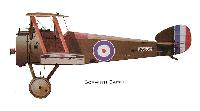 |
Сайт - Pilots-and-planes /WWW/
|
|
|
 |
В.Кондратьев - Самолеты первой мировой войны
|
| Сопвич "Кэмел" из 13-го дивизиона RNAS, пилот - капитан Раймонд Коллишоу, зима 1917-18гг.
|
 |
В.Кондратьев - Самолеты первой мировой войны
|
| Сопвич "Кэмел", 28-й дивизион RFC, пилот - капитан П.Уилсон, 1918г.
|
 |
Сайт - Pilots-and-planes /WWW/
|
| This Sopwith Camel F1 was named DIMPS III and carried highly colorful markings
|
 |
А.Шепс - Самолеты Первой мировой войны. Страны Антанты
|
| Истребитель Сопвич "Кэмел" F.1 RNAS
|
 |
W.Green, G.Swanborough - The Complete Book of Fighters
|
| Camel F.1 of No 65 Sqn, RFC, 1917.
|
 |
А.Шепс - Самолеты Первой мировой войны. Страны Антанты
|
| Истребитель Сопвич "Кэмел" E.1 RAF
|
 |
В.Обухович, А.Никифоров - Самолеты Первой Мировой войны
|
| Сопвич F.1 "Кэмел"
|
 |
W.Green, G.Swanborough - The Complete Book of Fighters
|
| A Camel of the Estonian Aviation Company at Tallinn, 1919
|
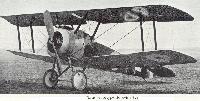 |
Сайт - Pilots-and-planes /WWW/
|
| The prototype Sopwith F.1
|
 |
Сайт - Pilots-and-planes /WWW/
|
| F.1 Camel first prototype
|
 |
H.King - Sopwith Aircraft 1912-1920 /Putnam/
|
| In a winter wonderland at Brooklands stands the first of all Camels with one-piece top wing and 110 hp Clerget engine (immaculately cowled). There is no separate windscreen, but the marked slope of the 'hump' to the front rim of the cockpit is clearly seen. Though frequently copied, this picture is a true original, uncaptioned by Sopwith.
|
 |
Сайт - Pilots-and-planes /WWW/
|
| F.1 Camel first prototype
|
 |
Сайт - Pilots-and-planes /WWW/
|
| A subsequent prototype
|
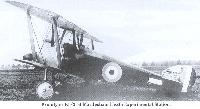 |
Сайт - Pilots-and-planes /WWW/
|
| Prototype F.1/3 at Martlesham Heath Experimental Station
|
 |
Сайт - Pilots-and-planes /WWW/
|
| Prototype F.1/3 at Martlesham Heath Experimental Station
|
 |
Сайт - Pilots-and-planes /WWW/
|
| Prototype F.1/3
|
 |
H.King - Sopwith Aircraft 1912-1920 /Putnam/
|
| This altogether superb and unfamiliar view of the 'Taper Wing Camel' is specially referred to in the text. The top wing is possibly in three sections. Over by the Sopwith sheds at Brooklands stands a Camel; between the tapered port wings of the clean experimental machine are glimpsed a D.H.2 single-seat pusher, a windsock and a speed-limit notice. To the left of the picture is a curious automotive vehicle.
|
 |
J.Bruce - British Aeroplanes 1914-1918 /Putnam/
|
| In this rear view of the F.1/1 'Taper Wing Camel' cut-outs in the apparently one-piece top wing are seen.
|
 |
Сайт - Pilots-and-planes /WWW/
|
| This Sopwith Camel once belonged to Hollywood film maker and aerobatic pilot, Frank Tallman. The aircraft carried the serial N6254 and was used in a large number of Hollywood aviation motion pictures including the Warner Brothers film, "Hell Bent for Glory"
|
 |
H.King - Sopwith Aircraft 1912-1920 /Putnam/
|
| With flattened 'hump', this early Sopwith-built Camel is probably N6332. The ribs along the tops of the gun breech-casings are seen; also a loading handle in the cockpit. Maker's caption:'S.122 - Sopwith Camel. 110 hp Clerget F.1. 2nd. Machine 1917.' There is a separate centre section, with rectangular cut-out, and the ailerons are lengthened.
|
 |
Сайт - Pilots-and-planes /WWW/
|
| N6332, one of the initial production batch
|
 |
В.Обухович, А.Никифоров - Самолеты Первой Мировой войны
|
|
|
 |
K.Delve - World War One in the Air /Crowood/
|
| The RNAS also acquired the Camel. This aircraft, N6336, was delivered to Martlesham for engine tests in May 1917 as it was one of a small batch with a 150hp BR.1. It was later operational with a number of units until, in October 1917, it became a Ground Instructional airframe.
|
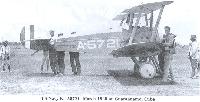 |
Сайт - Pilots-and-planes /WWW/
|
| US Navy F.1 A5721, March 1920 at Guantanamo, Cuba
|
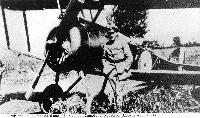 |
Сайт - Pilots-and-planes /WWW/
|
| Jacobsen standing in front of one of his victims, a Camel of 70 Squadron, B2307. 19 August 1917
|
 |
F.Mason - The British Fighter since 1912 /Putnam/
|
Despite early fears in some quarters that the type could not be used for night fighting, 44 Squadron had been the first Home Defence unit to equip with the Camel and proved that it was quite safe and effective.
B2402, a Ruston, Proctor-built F.1 Camel dedicated night fighter with twin Lewis guns on the double Foster mounting; the cockpit is in the aft position and a non-standard, faired head-rest has been added. This shot of B2402 is at Hainault Farm, which the squadron occupied from July 1917 to July 1919.
|
 |
Сайт - Pilots-and-planes /WWW/
|
| B2428
|
 |
Сайт - Pilots-and-planes /WWW/
|
| Lt. E G Forder, was taken prisoner by Austro-Hungary in B2455 on May 11 1918
|
 |
Сайт - Pilots-and-planes /WWW/
|
|
|
 |
J.Bruce - British Aeroplanes 1914-1918 /Putnam/
|
The two-seat conversion of the Camel for training purposes.
To emphasise the Camel's unforgiving nature, this rare image depicts Ser no B3801, one of the three known Camels converted to two-seat trainers during 1918, in an attempt to reduce the mounting number of fatalities encountered during type conversion flying.
|
 |
K.Delve - World War One in the Air /Crowood/
|
| It was not only the dedicated Home Defence Squadrons that took part in the battle; other units sent aircraft up. On 22 August Flt. Lt. A. Brandon was flying Camel B3834, from the War Flight at Manston, when he attacked a number of Gothas; of the 10 aircraft on the raid, three were shot down by anti-aircraft and aeroplane attacks, and Brandon was involved in at least one of these victories. The 'Wonga Bonga' graphic refers to the noise that the Gotha engines made.
|
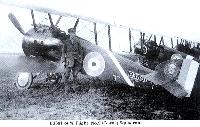 |
Сайт - Pilots-and-planes /WWW/
|
| B3881 of 'A' Flight, No.9 (Naval) Squadron
|
 |
Сайт - Pilots-and-planes /WWW/
|
| Lt. O C Le Boutillier of No.9 (Naval) Squadron with B3883 on August 4 1917
|
 |
H.King - Sopwith Aircraft 1912-1920 /Putnam/
|
| Two F.1s with a difference:Top, B9268 with a Hythe camera gun to port and a hole in the hump' lor the starboard Vickers (and with pupil-pilots behind waiting to 'have a go'); bottom. B3891 of Sopwith's second production batch, in which the French installed one of their new 170 hp Le Rhone 9R engines. This was the Camel's most powerful engine, and at least two installations were made.
|
 |
Сайт - Pilots-and-planes /WWW/
|
| No.8 (Naval) Squadron at Mont-St-Eloi early in 1918
|
 |
Сайт - Pilots-and-planes /WWW/
|
| B3922 of Naval Eight at Manstone in Autumn 1918
|
 |
Журнал - Flight за 1918 г.
|
| WITH THE BRITISH FORCES IN ITALY. - Scene at an aerodrome.
|
 |
K.Delve - World War One in the Air /Crowood/
|
| With their Squadron markings prominent on the fuselage these are Camels of 45 Squadron. B5152 was with the Squadron for a few weeks from early October 1917 but was shot down on 26 October, 2nd Lt. E. Smith being taken prisoner. In some records B3925 does not appear as having served with the unit - although this photograph is fairly unequivocal.
|
 |
Сайт - Pilots-and-planes /WWW/
|
| This Camel (B3926) of the Royal Naval Air Service was named Happy Hawkins and based at RNAS Sandown on the Isle of Wright during 1918. It was flown by D.M.B.Galbraith (DSC and Bar) an ace with fourteen victories to his credit while attached to No 8 Naval Squadron. He later served with No 204 Training Depot Station at Eastchurch
|
 |
Сайт - Pilots-and-planes /WWW/
|
| B3950 running its Clerget engine
|
 |
Сайт - Pilots-and-planes /WWW/
|
|
|
 |
F.Mason - The British Fighter since 1912 /Putnam/
|
| An unarmed Boulton & Paul-built F.1 Camel, B5234, in a distinctly unofficial livery, possibly photographed after the War, suggesting that it was the personal transport of a senior officer.
|
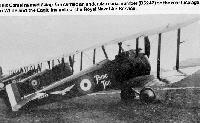 |
Сайт - Pilots-and-planes /WWW/
|
| This Camel Tsing Tau carried an undersize serial number (B5243) on the rear fuselage in White and the Eagle insignia of the Royal Naval Air Service
|
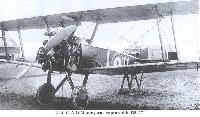 |
Сайт - Pilots-and-planes /WWW/
|
| 2/Lt. G A O Manley was captured in B5417
|
 |
F.Mason - The British Fighter since 1912 /Putnam/
|
| A Sopwith-built F.1 Camel with 150hp B.R.1 rotary engine, B6230, of No. 9 (Naval) Squadron at Bray Dunes, France, the first squadron to be equipped with the fighter in June 1917.
|
 |
Сайт - Pilots-and-planes /WWW/
|
| B6234 on No.3 Squadron with a Clerget engine
|
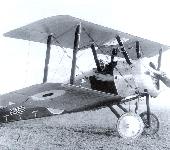 |
Сайт - Pilots-and-planes /WWW/
|
|
|
 |
K.Delve - World War One in the Air /Crowood/
|
| The RNAS and RFC made great use of the Camel from mid 1917 to the end of the war. B6299 served with 10 Squadron RNAS in late 1917 and scored a number ol victories; it subsequently returned to the UK to join 207 Training Depot Station at Chingford.
|
 |
K.Delve - World War One in the Air /Crowood/
|
| Maj. W.G. Barker poses with Camel B6313 of 139 Squadron. The squadron had formed at Villaveria, Italy in July 1918 and this was the only Camel in an otherwise Bristol Fighter-equipped unit.
|
 |
Сайт - Pilots-and-planes /WWW/
|
| Captain M B Frew logged at least ten combat in B6372
|
 |
Сайт - Pilots-and-planes /WWW/
|
| Lieutenant C J Kent's 130hp Clerget 9B Camel, B6385 No.3 Squadron, RFC, after capture in November
|
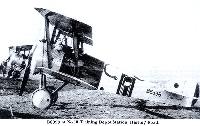 |
Сайт - Pilots-and-planes /WWW/
|
| B6398 at No.10 Training Depot Station, Harling Road
|
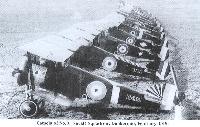 |
Сайт - Pilots-and-planes /WWW/
|
| Camels of No.3 (Naval) Squadron, Dunkerque, February 1918
|
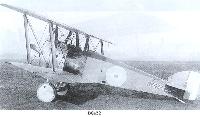 |
Сайт - Pilots-and-planes /WWW/
|
| B6422
|
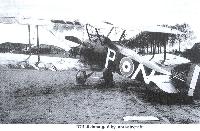 |
Сайт - Pilots-and-planes /WWW/
|
| B7320 damaged by anti-aircraft
|
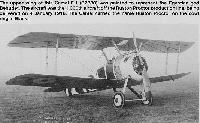 |
Сайт - Pilots-and-planes /WWW/
|
| The upper wing of thi Camel F.1 (B7380) was painted to represent the Egyptian god Behudet. The aircraft was the 1,000th aircraft off the Ruston Proctor production line, being delivered on 4 January 1918. The Camel carried the name Ruston Proctor on the cowl
|
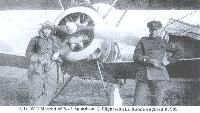 |
Сайт - Pilots-and-planes /WWW/
|
| 2/Lt. W H Maxted of No.3 Squadron 'C' Flight with Le Rhone engined B7905
|
 |
F.Mason - The British Fighter since 1912 /Putnam/
|
| A standard F.1 Camel built by Boulton & Paul, B9175, and flown by No 44 Squadron as a night fighter during the late summer of 1917; the twin Vickers gun armament was later discarded as unsuitable for night fighting.
|
 |
Jane's All The World Aircraft 1919 /Jane's/
|
| Side View of the Sopwith "Camel" (130 h.p. Clerget engine).
|
 |
H.King - Sopwith Aircraft 1912-1920 /Putnam/
|
| B9287 was made by Boulton & Paul, was unusually marked, had the rearwardly-moved cockpit and two Lewis guns on Foster mountings.
|
 |
P.Lewis - The British Fighter since 1912 /Putnam/
|
Classic dog-fighter of the 1914-18 War, the Sopwith F.1. Camel.
C42 unit and location unknown
|
 |
Сайт - Pilots-and-planes /WWW/
|
| Australian Camel C121
|
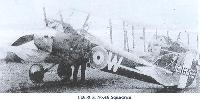 |
Сайт - Pilots-and-planes /WWW/
|
| C1659 of No.46 Squadron
|
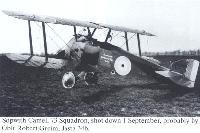 |
Сайт - Pilots-and-planes /WWW/
|
| Sopwith Camel, 73 Squadron, shot down 1 September, probably by Oblt Robert Greim, Jasta 34b
|
 |
Сайт - Pilots-and-planes /WWW/
|
| D8101 with No.66 Squadron
|
 |
K.Delve - World War One in the Air /Crowood/
|
| Aircraft production in Britain was by early 1918 efficient and large numbers of aircraft were being made available from a wide range of companies. Ruston Proctor built well over 1.000 Camels; here D8185 is seen at Monks Road, Lincoln on 1 June 1918 as part of a recruitment procession - the women being known as the 'Ruston Munitionettes'. The first unit for this particular aircraft was 471 Flight at Walmer.
|
 |
Сайт - Pilots-and-planes /WWW/
|
| Captain C M McEwen, MC, DFC, of No.28 Squadron, RAF, with D8239, post-Armistice
|
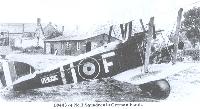 |
Сайт - Pilots-and-planes /WWW/
|
| D9443 of No.3 Squadron in German hands
|
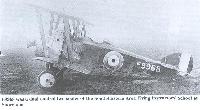 |
Сайт - Pilots-and-planes /WWW/
|
| E9968 was a dual-control two-seater of the South Eastern Area Flying Instructors' School at Shoreham
|
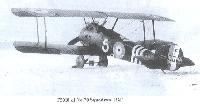 |
Сайт - Pilots-and-planes /WWW/
|
| F2010 of No.70 Squadron, RAF
|
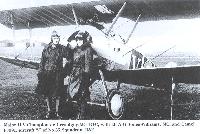 |
Сайт - Pilots-and-planes /WWW/
|
| Major H V Champion de Crespigny, MC, DFC, with Lt. A G Jones-Williams, MC and Camel F3991, aircraft 'V' of No.65 Squadron, RAF
|
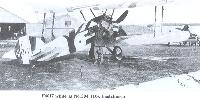 |
Сайт - Pilots-and-planes /WWW/
|
| F4017 while at No.204 TDS, Eastchurch
|
 |
Сайт - Pilots-and-planes /WWW/
|
|
|
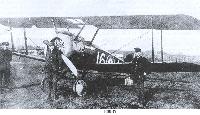 |
Сайт - Pilots-and-planes /WWW/
|
| F6037
|
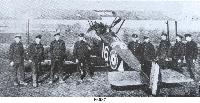 |
Сайт - Pilots-and-planes /WWW/
|
| F6037
|
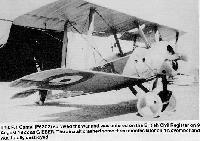 |
Сайт - Pilots-and-planes /WWW/
|
| This F.1 Camel (F6302) survived the war and was entered on the British Civil Register on 9 August 1922 as G-EBER. The aircraft crashed some three month later on 4 November and was totally destroyed
|
 |
K.Delve - World War One in the Air /Crowood/
|
| The Sopwith Camel is regarded by many as the finest fighter of the First World War; F6394 was from one of the last Boulton-Paul batches of Camels and was delivered to Martlesham Heath in September 1918.
|
 |
H.King - Sopwith Aircraft 1912-1920 /Putnam/
|
| Hooper-built H826 was one of the H734-H833 batch of F.1 Camels specially equipped for night fighting, though having standard twin-Vickers armament and normal cockpit position.
|
 |
Сайт - Pilots-and-planes /WWW/
|
| H7009 of No.209 Squadron, RAF
|
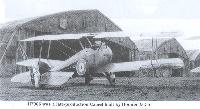 |
Сайт - Pilots-and-planes /WWW/
|
| H7386 was a late-production Camel built by Hooper & Co.
|
 |
В.Кондратьев - Самолеты первой мировой войны
|
| Один из первых серийных экземпляров "Кэмела", 1917 г.
|
 |
P.Hare - Royal Aircraft Factory /Putnam/
|
| Rival British fighters, the Sopwith Camel (foto) and the Factory's S.E.5a. Together they finally wrested aerial supremacy from the Germans.
|
 |
В.Обухович, А.Никифоров - Самолеты Первой Мировой войны
|
|
|
 |
J.Bruce - British Aeroplanes 1914-1918 /Putnam/
|
| F. 1 Camel with additional flying wires.
|
 |
Журнал - Flight за 1918 г.
|
| Three-quarter front view of the Sopwith "Camel."
|
 |
H.Cowin - Aviation Pioneers /Osprey/
|
| First flown in March 1917, the Sopwith IF Camel, like that of its precursor, the Pup, was the joint brainchild of Sopwith's pilot Harry Hawker and engineer Fred Sigrist. Unlike the Pup, however, the Camel never basked in its pilot's unmitigated delight at its handling, indeed, the Camel's capricious in-flight behaviour left not just much to be desired, but many young, inexperienced Camel pilots dead. The Camel's problems, which could also be used to effect by experienced fliers, stemmed from the fact that much of its mass, comprising engine, twin .303-inch Vickers guns, pilot and fuel, all lay within the first 7 feet of its overall 18.75 feet fuselage length, This, combined with the high torque reaction involved with its 130hp Clerget 9B rotary and, in particular, the short rudder moment arm, ensured that the machine turned to starboard, or the right, with breathtaking rapidity, while causing the nose to drop. If this tight turn was not rapidly corrected with rudder, the aircraft would readily enter a spin from which it was difficult to escape at low altitude. In the case of a turn to port, or to the left, the rate of turn was far less ferocious, while this time the nose rose. So long as he survived the initial familiarisation phase of Camel flying, the pilot could then use these characteristics to effect, by using its 'instant' starboard turning capability to out-turn his enemy and, thus, rapidly position himself behind his foe. Operational deployment of the Camel came in July 1917, with deliveries of the machine going to both RFC and RNAS squadrons. The IF Camel's top level speed of 115mph at 6,500 feet fell off to 106.5mph at 15,000 feet, while the single seater reached 10.000 feet in 10 minutes, 35 seconds while on its way to its 17.300 feet ceiling. Besides the standard Clerget, other rotaries were fitted to various IF batches, ranging from 110hp Le Rhones to the 150hp Bentley BR I. The image is the Sopwith IF Camel of No 139 Squadron, RFC's leader, the then Capt W.G. Barker, whose mount carried seven, rather than the unit's normal four fuselage white stripes aft of the roundel.
|
 |
J.Bruce - British Aeroplanes 1914-1918 /Putnam/
|
A two-gun Camel F.1 in RFC service, with bombs under the fuselage
Camels were often used for bombing, and a bombed-up machine (4 x 16 lb or 20 lb) is seen in the picture.
|
 |
В.Кондратьев - Самолеты первой мировой войны
|
| "Кэмел" ВВС РККА. 1920 год.
|
 |
K.Delve - World War One in the Air /Crowood/
|
| Camel of 66 Squadron. With its good all-round performance and twin Vickers guns, the Camel was a potent fighter in the hands of experienced pilots.
|
 |
O.Thetford - Aircraft of the Royal Air Force since 1918 /Putnam/
|
Night-fighter version of the Camel with pilot’s cockpit moved aft and armed with twin Lewis guns.
A characteristically drab, full-standard F.1 Camel night fighter of No 51 Squadron, almost certainly at Marham, Norfolk, in 1918. The Squadron was then ostensibly a Home Defence night fighter unit, but was also engaged in crew training.
|
 |
H.King - Sopwith Aircraft 1912-1920 /Putnam/
|
73 Squadron Camel after a mid-air collision on 20 May 1918. The squadron was operating from Beauvois, where they had been since March.
Evidently copied by a Sopwith photographer at the same time as a better-known 3/4 front view of a different Camel with a smashed port bottom wing, this is: 'S.481A - Camel F.1 which collided in the air and landed safely. - May 20/18'. Note ring sight on starboard gun and propeller for air-driven petrol pump on rear starboard centre-section strut.
|
 |
Журнал - Flight за 1918 г.
|
| Three-quarter rear view of the Sopwith "Camel."
|
 |
F.Mason - The British Fighter since 1912 /Putnam/
|
| With serial number and unit markings obscured by what appears to be black dope overall, this anonymous Camel night fighter is a standard F.1 with twin Vickers guns but with flare brackets and navigation lights on the wings.
|
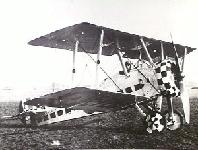 |
Сайт - Pilots-and-planes /WWW/
|
|
|
 |
J.Bruce - British Aeroplanes 1914-1918 /Putnam/
|
| F.1 Camel with Gnome Monosoupape engine.
|
 |
J.Bruce - British Aeroplanes 1914-1918 /Putnam/
|
| F.1 Camel with 150 h.p. B.R.1 engine. The slots in the cowling were made to provide additional cooling for ground-attack duties.
|
 |
H.Cowin - Aviation Pioneers /Osprey/
|
| Elliott White Springs, son of a reasonably wealthy mill owner, was born in South Carolina on 31 July 1896. It was while White Springs was at Princeton University that America entered the war in April 1917. Filled with the patriotic zeal of youth, along with an initial introduction to aviation provided by Princeton, White Springs gained a commission in the US Army and set sail for Britain and six months of flying training in September 1917. During his training, White Springs was fortunate enough to benefit from the tutelage of Canadian fighter ace 'Billy' Bishop. Clearly, White Springs, himself must have been an excellent pupil, for, later, when Bishop, as leader of the RAF's crack No 85 Squadron, was busy readying the unit for operations with their Royal Aircraft Factory SE 5a, he invited White Springs to join him. On 22 May 1918, No 85 Squadron crossed the English Channel and ten days later White Springs got his first confirmed 'kill' in the shape of a Pfalz D III. By 27 June 1918, the youthful American's score had risen to 4, at which time he was shot down and slightly wounded himself.. In July he was transferred, as a flight commander, to the all-American, Sopwith Camel-equipped 148th Aero Squadron attached to the British 65 Wing. Here, with the 148th Aero, between 3 August 1918 and 5 September 1918, White Springs was to add a further eight victories to his tally, bringing his final wartime total to 12. In October 1918 White Springs was promoted to Captain and given command of the 148th, now re-assigned to the US 4th Pursuit Group. Not happy with life back in the US after the war, White Springs returned to Paris, where he wrote a best seller 'War Birds', based on his experiences. Later and now more settled, White Springs returned to the US, taking the family business to new heights. Elliott White Springs, seen here standing beside his British marked Sopwith Camel, died on 15 October 1959.
|
 |
K.Delve - World War One in the Air /Crowood/
|
| 73 Squadron Camel at Hervilly October 1918. with Lt. Baker. Lt. Reid and Lt. Stieber.
|
 |
K.Delve - World War One in the Air /Crowood/
|
| 65 Squadron pilots with one of their Sopwith Camels; the Squadron had acquired Camels in October as they departed tor France.
|
 |
K.Delve - World War One in the Air /Crowood/
|
| Aircrew of 208 Squadron pose with their Camels: the Squadron had formed at Dunkirk from the old 8 Squadron RNAS upon the formation of the Royal Air Force.
|
 |
K.Delve - World War One in the Air /Crowood/
|
| The deleted aircraft serials on this line of 73 Squadron Camels are an attempt to censor the picture.
|
 |
O.Thetford - British Naval Aircraft since 1912 /Putnam/
|
| Sopwith F.I. Camels of No.10 (Naval) Squadron seen on the Western Front in 1918.
|
 |
K.Delve - World War One in the Air /Crowood/
|
| 226 Squadron Camels at Taranto; the unit was formed from a number of RNAS Flights in April 1918 and was involved in a variety of roles over and around the Adriatic.
|
 |
K.Delve - World War One in the Air /Crowood/
|
| A number of Allied Squadrons deployed to Italy to help bolster the air assets during periods when the Austrians were dominant. This photograph is captioned 'Italy 1918 and a line-up of 45 Squadron camels'. The unit moved to Italy in December 1917 and stayed there until the following September but this may have been taken in France before their departure.
|
 |
Журнал - Flight за 1918 г.
|
| WITH THE BRITISH FORCES IN ITALY. - The squadron that has accounted for many Hun planes, lined up before departure.
|
 |
Jane's All The World Aircraft 1919 /Jane's/
|
| A row of "Camels" built by Boulton & Paul, Ltd.
|
 |
K.Delve - World War One in the Air /Crowood/
|
| 50 Squadron received its first Camels in May 1918 as part of an effort to boost the Home Defence squadrons' capabilities to combat day and night raiders.
|
 |
C.Owers, J.Herris - Hannover Aircraft of WWI /Centennial Perspective/ (46)
|
| View of 13199/17 at an Air Depot in France after capture. A Sopwith Camel is undergoing repair in the background.
|
 |
W.Green, G.Swanborough - The Complete Book of Fighters
|
| One of the few surviving Camels, this 2F.1 is now preserved in the US Marine Corps Museum.
|
 |
В.Кондратьев - Самолеты первой мировой войны
|
| Еще один пример отличной работы реставраторов: Сопвич "Кэмел" на новозеландском ретроавиашоу.
|
 |
H.King - Sopwith Aircraft 1912-1920 /Putnam/
|
| Camel probably from Boulton & Paul, with local colour and local talent.
|
 |
Журнал - Flight за 1917 г.
|
| AT THE RECENT SOPWITH SPORTS AT NORBITON. - A snap of a Sopwith "Camel" during an exhibition flight.
|
 |
H.King - Armament of British Aircraft /Putnam/
|
| How ihe Camel's hump developed: top, first Camel with original form of fairing over breech casings of guns; lower, second Camel with revised fairings for guns.
|
 |
H.King - Armament of British Aircraft /Putnam/
|
| The third (tapered-wing) Camel, showing immaculate gun installation and fairings at front end of guns.
|
 |
H.King - Armament of British Aircraft /Putnam/
|
| The Camel at war, with a gun installation that is hardly immaculate, since the addition of chutes, sights, screen and, in this instance, a camera gun to port.
|
 |
В.Обухович, А.Никифоров - Самолеты Первой Мировой войны
|
|
|
 |
Журнал - Flight за 1918 г.
|
| The arrangement of the machine guns and telescopic sight on the Sopwith "Camel."
|
 |
Журнал - Flight за 1918 г.
|
| The 130 h.p. Clerget motor of the Sopwith "Camel," seen from the front.
|
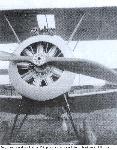 |
Сайт - Pilots-and-planes /WWW/
|
| Only Naval Squadrons had the 150-hp Bentley BR1 Camels for at least some of the time
|
 |
A.Jackson - British Civil Aircraft since 1919 vol.3 /Putnam/
|
| Sopwith Camel
|
 |
J.Herris - Pfalz Aircraft of WWI /Centennial Perspective/ (5)
|
| Pfalz D.XII 2695/18 in late-style camouflage with crosses obscured is in Allied hands postwar; a Sopwith Camel is in the background in the top photo. Barely visible is the zig-zag vertical band on the fuselage.
|
 |
G.Swanborough, P.Bowers - United States Military Aircraft since 1909 /Putnam/
|
| A Navy Sopwith Camel in France.
|
 |
Сайт - Pilots-and-planes /WWW/
|
| A Sopwith Camel undergoing engine maintenance
|
 |
A.Brew - Boulton Paul Aircraft since 1915 /Putnam/
|
| The front fuselage of a Sopwith Camel under construction at Riverside.
|
 |
Журнал - Flight за 1919 г.
|
| Fig. 8a. - Braced N-girder fuselage. Camel.
|
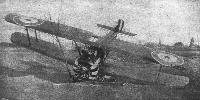 |
Журнал - Flight за 1918 г.
|
| A Sopwith single-seater fighter shot down in an aerial fight on the Western Front. Note the peculiar painting on the engine cowl and the two fixed machine guns.
|
 |
H.King - Sopwith Aircraft 1912-1920 /Putnam/
|
| Repose in a shell-hole - and affording an excellent view of the long Aldis sight between the guns, the air-driven pump on the front starboard strut, etc.
|
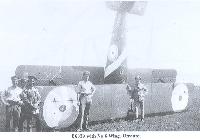 |
Сайт - Pilots-and-planes /WWW/
|
| B6339 with No.6 Wing, Otranto
|
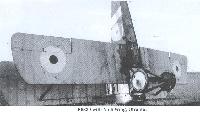 |
Сайт - Pilots-and-planes /WWW/
|
| B6339 with No.6 Wing, Otranto
|
 |
H.King - Sopwith Aircraft 1912-1920 /Putnam/
|
| Camels were often used for bombing, but to force-land, as otherwise depicted here, with a bomb still on the carrier (as it obviously is) could surely be unhealthy. Did the horsemen know?
|
 |
В.Обухович, А.Никифоров - Самолеты Первой Мировой войны
|
|
|
 |
Сайт - Pilots-and-planes /WWW/
|
| Prototype crashed by Sous-Leitenant Canivet, in France
|
 |
K.Delve - World War One in the Air /Crowood/
|
| Camel B7227 of 10 Squadron RNAS having come to grief behind the German lines after being attacked and shot down on June 21 by four Fokker DVIIs; 2nd Lt. R.G. Carr was taken prisoner.
|
 |
А.Шепс - Самолеты Первой мировой войны. Страны Антанты
|
| Английский истребитель Сопвич "Кэмл" и германский "Альбатрос"
|
 |
W.Green, G.Swanborough - The Complete Book of Fighters
|
| Sopwith F.1 Camel
|
 |
Журнал - Flight за 1919 г.
|
| Side elevations of the Sopwith machines
|
 |
Журнал - Flight за 1919 г.
|
| Front elevations of the Sopwith machines
|
 |
Журнал - Flight за 1919 г.
|
| Plan views of Sopwith machines
|
 |
Сайт - Pilots-and-planes /WWW/
|
|
|
 |
H.King - Sopwith Aircraft 1912-1920 /Putnam/
|
| Official F.1 Camel drawing.
|
 |
Журнал - Flight за 1918 г.
|
| Side elevation and. plan of the fuselage of the Sopwith "Camel."
|
 |
Jane's All The World Aircraft 1919 /Jane's/
|
| General Arrangement of the Sopwith "Camel" (130 h.p. Clerget engine).
|
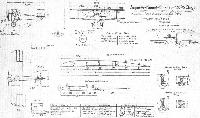 |
Журнал - Flight за 1918 г.
|
| General arrangement, and some details, of tbe Sopwlth "Camel."
|
 |
F.Mason - The British Fighter since 1912 /Putnam/
|
|
|
 |
W.Green, G.Swanborough - The Complete Book of Fighters
|
| A three-view drawing of the standard Camel fighter.
|
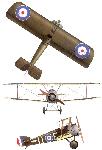 |
Сайт - Pilots-and-planes /WWW/
|
|
|
 |
В.Кондратьев - Самолеты первой мировой войны
|
| Sopwith Camel
|





















































































































































